SCHEME OF WORK
Week Topic
1. Speech work/Listening and speaking: Revision of Sounds-Vowels –/a/,/e/,/ i/, /ə/,/u/,etc. Grammar –Revision of speech- noun, pronoun, verbs and adjectives. Reading – Reading to understand the writer’s purpose. Writing –Writing an outline for the Narrative Essay –Topic “How I spent my last Holiday”. Literature in English- Types of Prose e.g. Narrative, Descriptive etc. features of a prose e.g. Plot, Style, Setting, Theme, Characterization
2. Speech work/Listening and Speaking:-Consonant sounds: /t, g, k, l, p, s/, etc. Vocabulary Development on “The Family”- Nuclear/Extended .Words related to the family. Grammar- Parts of Speech- verbs and transitive and intransitive verbs. Reading – Words in context: Knowing and identifying words in context. Writing: Types of composition-Narrative, Descriptive, Argumentative, Expository, elements of composition writing- introduction, Body and conclusion, pre writing, writing, editing, arrangement of ideas. Literature – in English: - Figures of Speech Simile, Metaphor etc
3. Speech work/Listening and speaking; Intonation, Stress and Rhythm: Grammar:-Question Tags. Register on the Neighborhood and Discipline in School. Reading and Comprehension .Reading for Critical Evaluation. Writing: - Types of formal letters features of formal letter. Writing “Application for Employment”. Literature – in English: - Oral Literature Myths and Legends Reading recommended text.
4. Speech Work: Long and Short Vowels: Contrasting- /i:/&/i/, e.g. beans/bins,/u:/&/u/ e.g. fool, full, Grammar –Active and passive voice. Reading/Comprehension and summary writing. Vocabulary Development on Law and Order. Writing-Summary Writing. Point to note Literature – in English:- Folktales-(African and Non-African) Features- didactic, entertainment, magical, myths and legends. Reading recommended text
5. Speech work/Listening and speaking:-consonants- so, sit, cell, zero, zoo, freezer, rise (as in /s/, /z/ either feather, mother, father (as in /ə/.). Grammar; Structure; “The WH” Question: Who, Where, When, Why, What. Register on “School Administration”. Reading and Comprehension. Writing: - Features and outline of an informal letters. Literature – in English:-Figures of Speech- Alliteration and Assonance Reading Recommend Text
6. Speech Work:-Types of vowels- Monophthongs, Diphthongs and Triphthongs. Treating Diphthongs /au/, /ei/, /eə/ and /ai/. Grammar: - Tenses (Present, Past and Future). Reading, Comprehension and Summary. Reading for Speed – Survey, Scan and skim. Writing – Narrative Essay – “A Village Market”. Literature – in- English:-Irony and Paradox. Reading the recommended text.
7. Speech work/Listening and speaking:-Morphemes- Word boundaries – Prefix. Grammar: - Prepositions and Prepositional Phrases. Reading and Comprehension Summary Writing- Selected by the teacher. Writing – Narrative Essay on “What I do Everyday” Literature – in -English:-Recommended Text.
8. Speech work – Suffix. Grammar – Conjunction, types and usages. , Vocabulary development – on Sports. Reading and Comprehension. Writing- Stating the differences between Formal and Informal Letters. Literature – in – English:-Figures of Speech.
9. Speech work/Listening and speaking: - Monophthongs. Grammar: Making Request using- will, could, please e.g. could you please come? Will you make out time, please? Reading and Comprehension. Writing – Formal Letter of Invitation (As a Guest Speaker).Literature – in – English: - Other Figures of Speech. Reading Recommended Text
10. Revision.
1ST TERM
WEEK 1
LESSON 1
READING COMPREHENSION
TOPIC: Advances in Modern Medicine
When you read, ask yourself what the writer’s purpose is- to inform, to warn, to entertain, to persuade .In this passage, the writer wishes to learn many new things. His purpose is to inform you. When you read, look out for topic sentences. A topic sentence is that sentence or sentences in a paragraph that contain(s) the main idea of the paragraph.

Check your Dictionary for the meaning of the following words
Diagnose, transfusion, antibiotic, immunization, bacteriologist, gynaecologist, radiologist,
dermatologist, gerontologist, vaccination.
EVALUATION: Intensive English book for JSS2; Exercises 1.2.2 and 1.2.3;Pages 3-5
ASSIGNMENT:Intensive English book for JSS2; Exercise 1.2.4, 1.2.5 and 1.3.5; Pages 5-12
LESSON 2
TOPIC: COMPOSITION
SUB-TOPIC: HOW I SPENT MY LAST HOLIDAY
CONTENT:
A narrative essay is an essay in which you tell the story or give an account of what has happened. ”How I Spent my Last Holiday” is a narrative essay because it gives an account of what has happened. It should be true to life i.e.it should be believable because it is possible in real life.
In writing this essay, you must think carefully:what are the various stages in the sequence of events?
The holiday could be divided into weeks, so that the events of each week could be covered in a paragraph of the essay. Alternatively, you could divide the holiday into the various periods spent in particular places e.g at home, in Abuja,with your uncle or grand ma etc. and make a paragraph to cover the interesting or memorable events in each period.
The concluding paragraph must tell us your impressions or feelings at the end of the holiday and the preparation you have to make for the resumption at school.
In a narrative essay like this, past tense forms of verbs should be used because it recounts past events. Don’t use short forms like don’t, I couldn’t, I’m etc. and avoid the use of slangs.

EVALUATION:Students should be made to share with the class how they spent their last holiday.
LESSON 3
TOPIC: LITERATURE
SUB-TOPICS: Types of Prose
Features of Prose
CONTENT:
A Prose is a written or spoken language that is not in verse form.It’s structure is interms of sentences and paragraph.
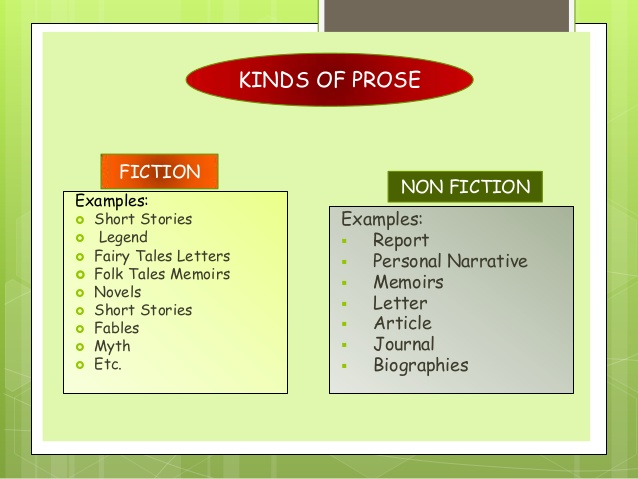
TYPES OF PROSE
Narrative Prose: This is a prose work that tells story
Descriptive Prose: This is a prose work that describes a thing, a person, a place, an event etc.
Features of Prose/Elements of Literature in a Prose Work
Plot, style, setting, theme, character, characterization.
PLOT: This is the arrangement or organization of events in a work of art. It follows the principles of cause and effect.
STYLE: It is the way a writer writes his work.
SETTING: This is the totality of the environment of a story. It refers to the period, place, atmosphere, etc.
THEME: This is the central or main idea that is discussed in a novel. It is what the work is all about, that is, the major message that is discussed in the work.
CHARACTER: The people that act in a play.
CHARACTERIZATION: This is the way the author reveals the peculiar qualities of his characters. It is also the way the author makes the characters seem real.

EVALUATION:
1. List and explain the features/element of literature in a prose work.
2. ______________ is prose work that tells a story.
ASSIGNMENT:
1. Write a narrative essay on “How I spent my Last Holiday”
2. List and explain the types of prose.
Further Studies
LESSON 4
Sounds
Topic: English Vowels a,e,i,o,u
https://youtu.be/zzzJ9iII5V8
Further Studies
READING COMPREHENSION
TOPIC: Advances in Modern Medicine
When you read, ask yourself what the writer’s purpose is- to inform, to warn, to entertain, to persuade .In this passage, the writer wishes to learn many new things. His purpose is to inform you. When you read, look out for topic sentences. A topic sentence is that sentence or sentences in a paragraph that contain(s) the main idea of the paragraph.

Check your Dictionary for the meaning of the following words
Diagnose, transfusion, antibiotic, immunization, bacteriologist, gynaecologist, radiologist,
dermatologist, gerontologist, vaccination.
EVALUATION: Intensive English book for JSS2; Exercises 1.2.2 and 1.2.3;Pages 3-5
ASSIGNMENT:Intensive English book for JSS2; Exercise 1.2.4, 1.2.5 and 1.3.5; Pages 5-12
LESSON 2
TOPIC: COMPOSITION
SUB-TOPIC: HOW I SPENT MY LAST HOLIDAY
CONTENT:
A narrative essay is an essay in which you tell the story or give an account of what has happened. ”How I Spent my Last Holiday” is a narrative essay because it gives an account of what has happened. It should be true to life i.e.it should be believable because it is possible in real life.
In writing this essay, you must think carefully:what are the various stages in the sequence of events?
The holiday could be divided into weeks, so that the events of each week could be covered in a paragraph of the essay. Alternatively, you could divide the holiday into the various periods spent in particular places e.g at home, in Abuja,with your uncle or grand ma etc. and make a paragraph to cover the interesting or memorable events in each period.
The concluding paragraph must tell us your impressions or feelings at the end of the holiday and the preparation you have to make for the resumption at school.
In a narrative essay like this, past tense forms of verbs should be used because it recounts past events. Don’t use short forms like don’t, I couldn’t, I’m etc. and avoid the use of slangs.

EVALUATION:Students should be made to share with the class how they spent their last holiday.
LESSON 3
TOPIC: LITERATURE
SUB-TOPICS: Types of Prose
Features of Prose
CONTENT:
A Prose is a written or spoken language that is not in verse form.It’s structure is interms of sentences and paragraph.

TYPES OF PROSE
Narrative Prose: This is a prose work that tells story
Descriptive Prose: This is a prose work that describes a thing, a person, a place, an event etc.
Features of Prose/Elements of Literature in a Prose Work
Plot, style, setting, theme, character, characterization.
PLOT: This is the arrangement or organization of events in a work of art. It follows the principles of cause and effect.
STYLE: It is the way a writer writes his work.
SETTING: This is the totality of the environment of a story. It refers to the period, place, atmosphere, etc.
THEME: This is the central or main idea that is discussed in a novel. It is what the work is all about, that is, the major message that is discussed in the work.
CHARACTER: The people that act in a play.
CHARACTERIZATION: This is the way the author reveals the peculiar qualities of his characters. It is also the way the author makes the characters seem real.

EVALUATION:
1. List and explain the features/element of literature in a prose work.
2. ______________ is prose work that tells a story.
ASSIGNMENT:
1. Write a narrative essay on “How I spent my Last Holiday”
2. List and explain the types of prose.
Further Studies
LESSON 4
Sounds
Topic: English Vowels a,e,i,o,u
https://youtu.be/zzzJ9iII5V8
Further Studies
WEEK 2
LESSON 5
ASPECT: COMPREHENSION
TOPIC: Controlling Mosquitoes
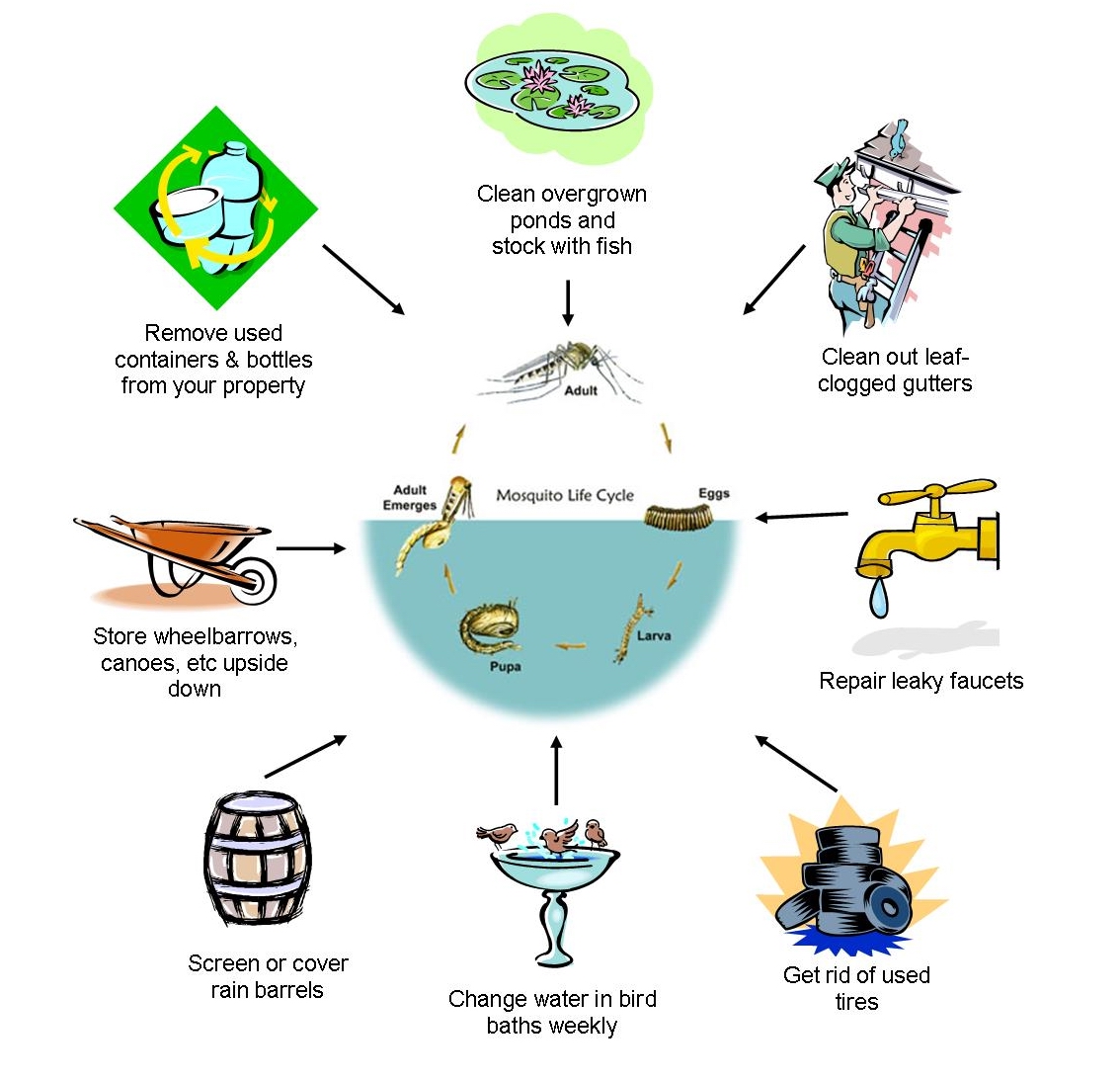
When you read, pay attention to devices used by the writer to express his ideas, make his point and convince the reader.
In this passage, notice the use of repetition. Repetition of words and phrases helps you to understand the idea better.
EVALUATION: Intensive English Book 2; Exercises 2.2.2 and 2.2.3; pages 18-19.
ASSIGNMENT: Intensive English Book 2;Exercises2.2.4, 2.2.5 and 2.3.5 pages 18-23.
Further Studies
LESSON 6
SPECIFIC TOPIC: Inflation
REFERENCE BOOKS: Macmillan Brilliant English Bk II, pages 2 - 3
PERFORMANCE OBJECTIVES: At the end of the lesson the students should be able to:
i. Read the passage fluently
ii. Answer questions on the passage
CONTENT:
Inflation is a state of disequilibrium in which too much money is chasing too few goods. There is much money with which to buy goods but few goods are available and their prices have been marked up.

Further Studies 1
Further Studies 2
EVALUATION:
i. Read the passage in your textbook
ii. Answer Question 4.
ASSIGNMENT
1. Answer questions 1 - 5, page 2 of Brilliant English Bk 2
2. Find out how many times the pump price of petrol has been increased in Nigeria since independence and submit your answer in the next class.
LESSON 7
TOPIC: SPEECH SOUND
SUB-TOPIC: CONSONANT / g, k, l, p, s /
CONTENT:
/ g, k, l, p, s / are consonant sounds.
/g/ -voiced velar plosive
e.g. goggle, dog, good, green
g-----gg-----gu----gh
give-beggar-guest--ghost
go----------tongue ghoul
angle-------guardian
gear
https://youtu.be/8H_Xis2wigA
/k/- voiceless velar plosive
e.g. key, catch, school,
k------c----cc
king---cat--tobacco
market-tac--Morocco
talk---arc--accord
wake---cool-account
ck-----qu------que
sick---quick---unique
bucket-request-opaque
trick—-quiet---Queue
stick--queen
ch---------x----chae
Chemist---six--Michael
School----taxi
Christmas-next
Anchor----text
https://youtu.be/6YJdNE8na9M
/l/- lateral sound
e.g. love, tall, fellow,
l---------ll
travel---collect
pedal----college
please---call
It appears most of the time the same in writing and speech except the silent l as in half, talk, palm, should, chalk, psalm, would, colonel etc
https://youtu.be/sXKFT02-nKw
/p/- voiceless plosive
E.g. price, puppy, pot.
p------pp
paper apple
proper supply
reply apple
stop
/p/ appear the same way in written and spoken form except for the silent p which belongs to other families of sound e.g.
coup, psalm, etc.
https://youtu.be/W3bI_PE_kNc
/s/- voiceless alveolar fricative
e.g. crease, purse, peace
c---------s--------ss-------ps--------sw------sc
cell------sing boss psalm sword scissors
concert---fuse gossip pseudopodia science
parcel----gospel class psychology scene
There are some silent s which are not /s/ such as Island, Isle and aisle
https://youtu.be/L3vyZaQF8vk
EVALUATION: Give word examples of these consonant sounds. /s/, /l/, /p/, /k/
LESSON 8
TOPIC: GRAMMAR
SUB-TOPIC: Verb-Transitive and Transitive Verb
CONTENT:
Verbs are used to say what people do. They express an action. E.g. laugh, walk, run, sleep, and takee.g. some verbs do not express an action. They just say people or things are something. E.g. the verb to be – am, is, are, was, were. Others are have, has, had, can, will, may, shall etc.
Transitive verb:
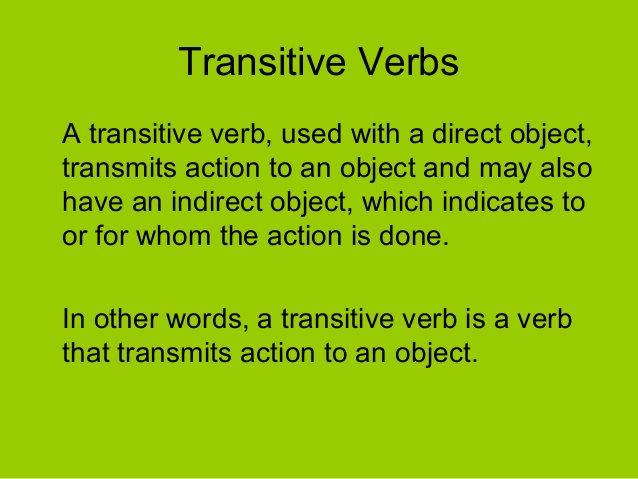
Before we discuss transitive verb there is the need to discuss object.
Object: Object is the receiver of the action. It shows somebody or something involved in the subject. It is what the verb is done to.e.g.
I took the book.(“book” is the object while “I” is the subject-the performer of the action)
Direct Object: refers to a person or thing affected by the action of the verb.
He opened the door (“door” is the direct object)
Transitive Verbs: they are verbs that take direct object. When a verb has an object that receives the action of the verb,that verb is transitive. E.g.
1. I sold some books.
2. Ngozi took the pen.
3. I understand her question.
4. The woman slapped the boy because he was rude.
The verbs “sold, took, understand, slap” in theabove sentences are transitive because they take the direct objects “books, bus, question, the boy”
Other examples of transitive verbs are have, broke, sold, bought, love, throw, develop, kick, eat, see etc.
Intransitive verb:
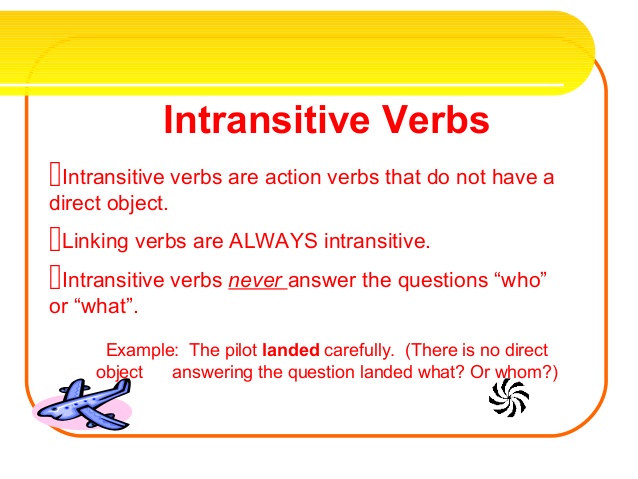
They are verbs that do not take object. So, a verb is intransitive when it does not have an object after it.E.g.
1. I slept at 7pm yesterday.
2. The students in the class are singing.
3. The pawpaw tree fell this morning.
4. She coughed.
The verbs”slept, singing, fell, coughed” are intransitive because they do not take verb what we find after the verbs in 1 and 2 are adverbs.
Other examples of intransitive verbs are run, cry, rise, live, result, dwell, swim, improve, sing etc.
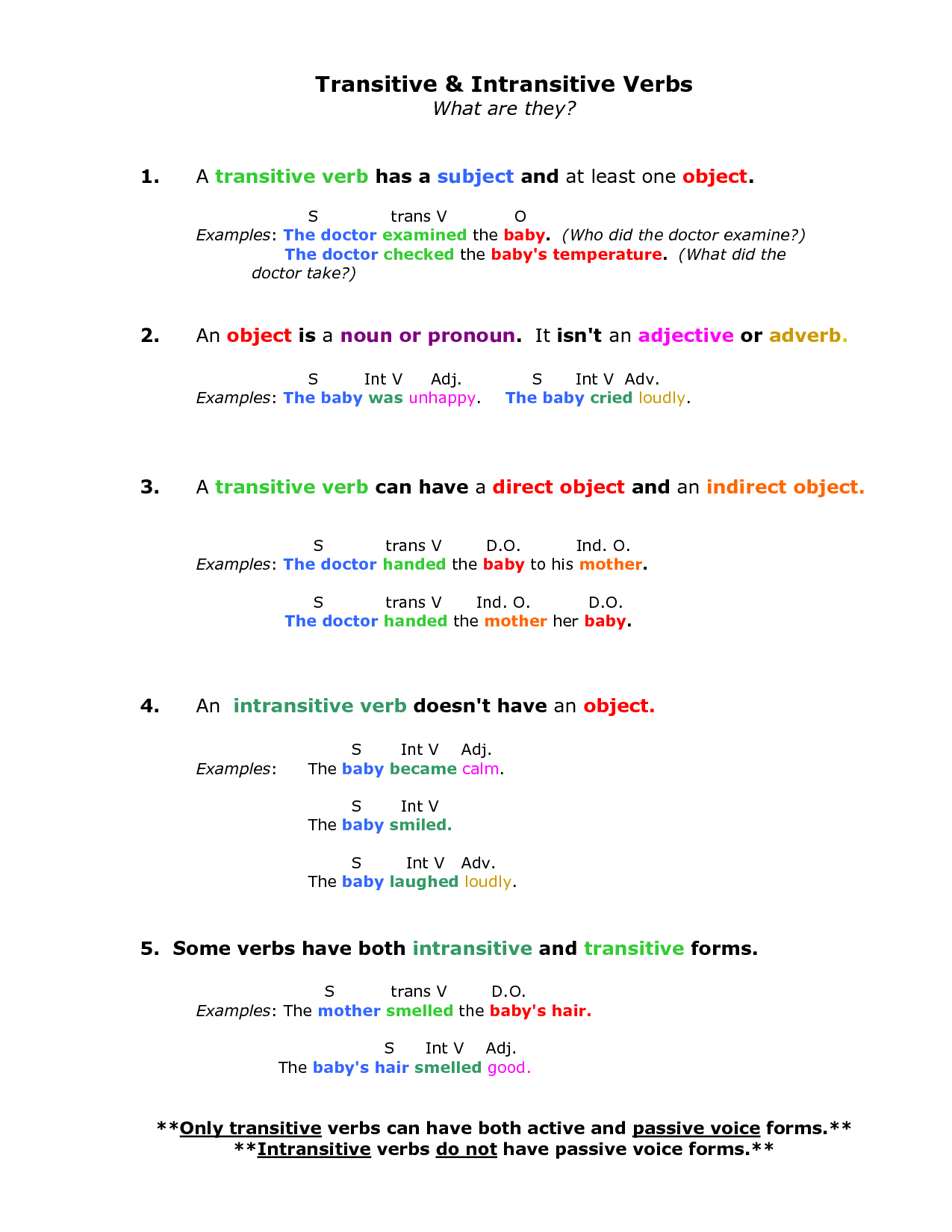
EVALUATION:
1. What is transitive verb?
2. Give five (5) examples of intransitive verb and make sentences with two of them.
Further Studies 1
Further Studies 2
Further Studies 3
Further Studies 4
Practice Test 1
Practice Test 2
Practice Test 3
LESSON 9
TOPIC: COMPOSITION
SUB-TOPIC: TYPES OF COMPOSITION
ELEMENTS OF COMPOSITION
CONTENT:
Types of Composition
They are narrative, descriptive, argumentative and expository.
NARRATIVE COMPOSITION: A narrative composition is a composition in which you tell the story or give an account of what has happened. The story could be a true one or could be made up yourself. Whichever way, however, it is important that it should be true to life i.e. it should be believable because it is possible in real life.
E.g. “A Journey I will never Forget”.

DESCRIPTIVE COMPOSITION: it is one that is written to give the reader a mental picture of a person, object or place. The composition should be written in such a way that the reader will have a good picture of the person, place or object in his mind.
E.g. ”Describe your school compound for someone who has not been there”.

ARGUMENTATIVE COMPOSITION: It is a composition written to argue that an opinion is superior to some other opinion. It is an essay written to persuade the reader to accept one opinion and reject some other opinion.
E.g. “Dry Season is Preferable to Rainy Season in Nigeria”

EXPOSITORY COMPOSITION: It is a composition that describes how something is done, planned or organized, made, how something works etc.
E.g. “Describe how your favourite meal is prepared”, or ” The Game I like best”.
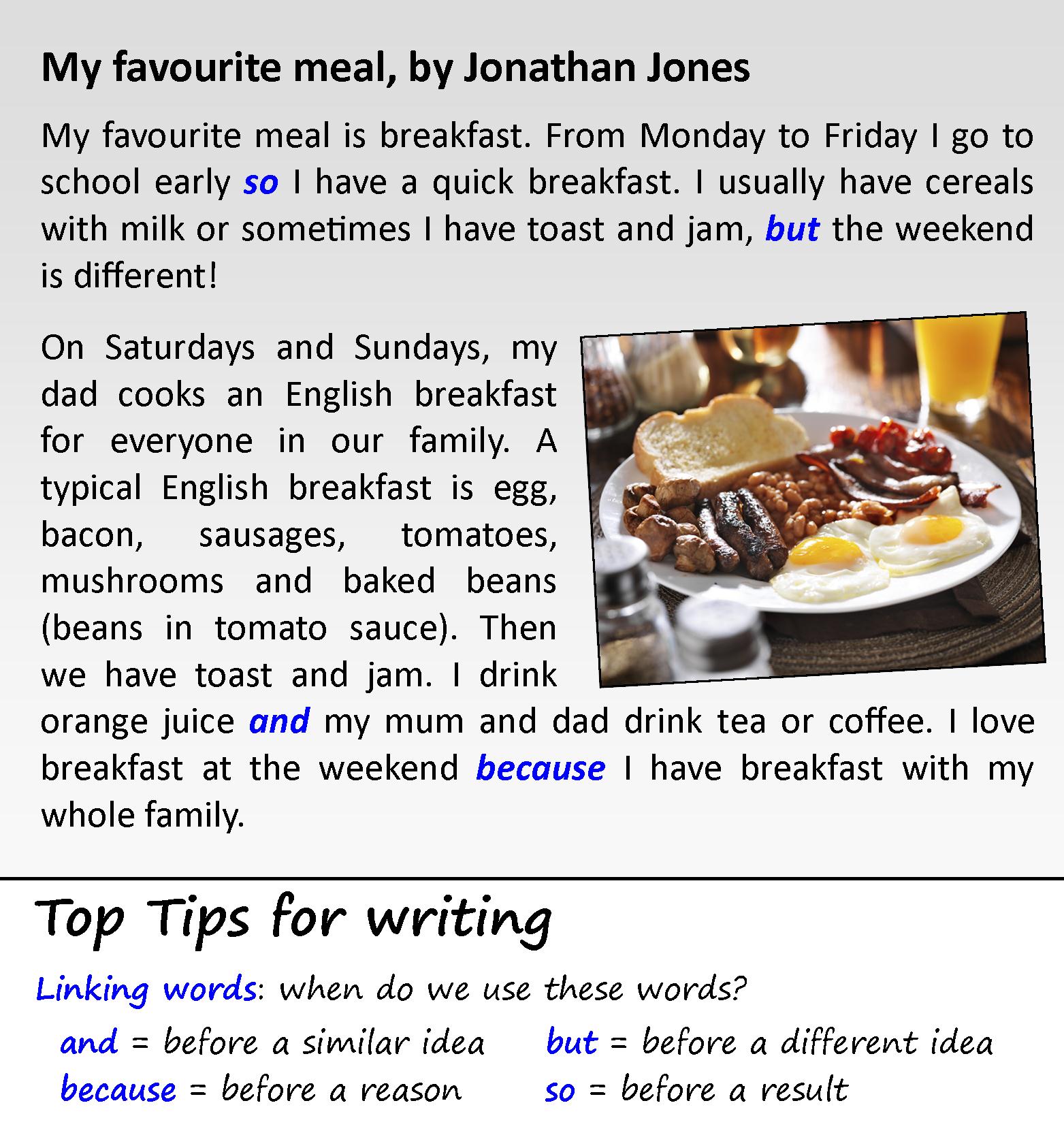
Elements of Composition
Introduction, body, conclusion, pre-writing, writing, arrangement of ideas, editing
EVALUATION:
1. List and explain the types of composition.
2. “Describe the teacher you liked best in your primary school”. What type of composition is this?
LESSON 10
TOPIC:LITERATURE
SUB-TOPIC: FIGURES OF SPEECH
CONTENT: Simile, metaphor, personification, and hyperbole

SIMILE: Simile is the description of a thing as being similar to another thing. It is usually introduced through the use of “as” and “like” e.g.
1. Dennis stood fluttering like a leaf.
2. He was as small as a rabbit.
3. Tolu is as gentle as a dove.
METAPHOR: It is a direct comparison of one thing with another. It says one thing is another thing. E.g.
1. I am the moth, and he is the gecko.
2. Judit is a dove.
PERSONIFICATION: Inanimate objects are treated as human beings. Human attributes are given to inanimate objects e.g.
1. Death knocks on her door.
2. My car is coughing.
HYPERBOLE: This is an overstatement or exaggeration for emphasis,comic effect or satirical effect. E.g.
1. I am so hungry that I can eat up a mountain of pounded yam.
2. I will fly to the moon to prove my love for you.
EVALUATION:
Identify the figures of speech used in the sentences below.
1. Thus the little minutes, humble though they be.
2. She came looking for you a million times.
3. Make this earth an Eden
4. Like the heaven above.
5. I will not leave my wife in a million years.
ASSIGNMENT:
Choose from the options lettered A-E the one that contains the given phonetic symbol
1. /s/
a. chicken
b. easy
c. essay
d. husband
e. sure
2. /k/
a. charity
b. cheat
c. chemist
d. chest
e. knight
3. /p/
a. Alpha
b. Page
c. Orphan
d. Phone
e. Physics
4. /l/
a. Psalm
b. Walk
c. Salmon
d. Talk
e. Shelter
5. /g/
a. manage
b. gnat
c. grove
d. George
e. malign
ASPECT: COMPREHENSION
TOPIC: Controlling Mosquitoes

When you read, pay attention to devices used by the writer to express his ideas, make his point and convince the reader.
In this passage, notice the use of repetition. Repetition of words and phrases helps you to understand the idea better.
EVALUATION: Intensive English Book 2; Exercises 2.2.2 and 2.2.3; pages 18-19.
ASSIGNMENT: Intensive English Book 2;Exercises2.2.4, 2.2.5 and 2.3.5 pages 18-23.
Further Studies
LESSON 6
SPECIFIC TOPIC: Inflation
REFERENCE BOOKS: Macmillan Brilliant English Bk II, pages 2 - 3
PERFORMANCE OBJECTIVES: At the end of the lesson the students should be able to:
i. Read the passage fluently
ii. Answer questions on the passage
CONTENT:
Inflation is a state of disequilibrium in which too much money is chasing too few goods. There is much money with which to buy goods but few goods are available and their prices have been marked up.

Further Studies 1
Further Studies 2
EVALUATION:
i. Read the passage in your textbook
ii. Answer Question 4.
ASSIGNMENT
1. Answer questions 1 - 5, page 2 of Brilliant English Bk 2
2. Find out how many times the pump price of petrol has been increased in Nigeria since independence and submit your answer in the next class.
LESSON 7
TOPIC: SPEECH SOUND
SUB-TOPIC: CONSONANT / g, k, l, p, s /
CONTENT:
/ g, k, l, p, s / are consonant sounds.
/g/ -voiced velar plosive
e.g. goggle, dog, good, green
g-----gg-----gu----gh
give-beggar-guest--ghost
go----------tongue ghoul
angle-------guardian
gear
https://youtu.be/8H_Xis2wigA
/k/- voiceless velar plosive
e.g. key, catch, school,
k------c----cc
king---cat--tobacco
market-tac--Morocco
talk---arc--accord
wake---cool-account
ck-----qu------que
sick---quick---unique
bucket-request-opaque
trick—-quiet---Queue
stick--queen
ch---------x----chae
Chemist---six--Michael
School----taxi
Christmas-next
Anchor----text
https://youtu.be/6YJdNE8na9M
/l/- lateral sound
e.g. love, tall, fellow,
l---------ll
travel---collect
pedal----college
please---call
It appears most of the time the same in writing and speech except the silent l as in half, talk, palm, should, chalk, psalm, would, colonel etc
https://youtu.be/sXKFT02-nKw
/p/- voiceless plosive
E.g. price, puppy, pot.
p------pp
paper apple
proper supply
reply apple
stop
/p/ appear the same way in written and spoken form except for the silent p which belongs to other families of sound e.g.
coup, psalm, etc.
https://youtu.be/W3bI_PE_kNc
/s/- voiceless alveolar fricative
e.g. crease, purse, peace
c---------s--------ss-------ps--------sw------sc
cell------sing boss psalm sword scissors
concert---fuse gossip pseudopodia science
parcel----gospel class psychology scene
There are some silent s which are not /s/ such as Island, Isle and aisle
https://youtu.be/L3vyZaQF8vk
EVALUATION: Give word examples of these consonant sounds. /s/, /l/, /p/, /k/
LESSON 8
TOPIC: GRAMMAR
SUB-TOPIC: Verb-Transitive and Transitive Verb
CONTENT:
Verbs are used to say what people do. They express an action. E.g. laugh, walk, run, sleep, and takee.g. some verbs do not express an action. They just say people or things are something. E.g. the verb to be – am, is, are, was, were. Others are have, has, had, can, will, may, shall etc.
Transitive verb:

Before we discuss transitive verb there is the need to discuss object.
Object: Object is the receiver of the action. It shows somebody or something involved in the subject. It is what the verb is done to.e.g.
I took the book.(“book” is the object while “I” is the subject-the performer of the action)
Direct Object: refers to a person or thing affected by the action of the verb.
He opened the door (“door” is the direct object)
Transitive Verbs: they are verbs that take direct object. When a verb has an object that receives the action of the verb,that verb is transitive. E.g.
1. I sold some books.
2. Ngozi took the pen.
3. I understand her question.
4. The woman slapped the boy because he was rude.
The verbs “sold, took, understand, slap” in theabove sentences are transitive because they take the direct objects “books, bus, question, the boy”
Other examples of transitive verbs are have, broke, sold, bought, love, throw, develop, kick, eat, see etc.
Intransitive verb:

They are verbs that do not take object. So, a verb is intransitive when it does not have an object after it.E.g.
1. I slept at 7pm yesterday.
2. The students in the class are singing.
3. The pawpaw tree fell this morning.
4. She coughed.
The verbs”slept, singing, fell, coughed” are intransitive because they do not take verb what we find after the verbs in 1 and 2 are adverbs.
Other examples of intransitive verbs are run, cry, rise, live, result, dwell, swim, improve, sing etc.

EVALUATION:
1. What is transitive verb?
2. Give five (5) examples of intransitive verb and make sentences with two of them.
Further Studies 1
Further Studies 2
Further Studies 3
Further Studies 4
Practice Test 1
Practice Test 2
Practice Test 3
LESSON 9
TOPIC: COMPOSITION
SUB-TOPIC: TYPES OF COMPOSITION
ELEMENTS OF COMPOSITION
CONTENT:
Types of Composition
They are narrative, descriptive, argumentative and expository.
NARRATIVE COMPOSITION: A narrative composition is a composition in which you tell the story or give an account of what has happened. The story could be a true one or could be made up yourself. Whichever way, however, it is important that it should be true to life i.e. it should be believable because it is possible in real life.
E.g. “A Journey I will never Forget”.

DESCRIPTIVE COMPOSITION: it is one that is written to give the reader a mental picture of a person, object or place. The composition should be written in such a way that the reader will have a good picture of the person, place or object in his mind.
E.g. ”Describe your school compound for someone who has not been there”.

ARGUMENTATIVE COMPOSITION: It is a composition written to argue that an opinion is superior to some other opinion. It is an essay written to persuade the reader to accept one opinion and reject some other opinion.
E.g. “Dry Season is Preferable to Rainy Season in Nigeria”

EXPOSITORY COMPOSITION: It is a composition that describes how something is done, planned or organized, made, how something works etc.
E.g. “Describe how your favourite meal is prepared”, or ” The Game I like best”.

Elements of Composition
Introduction, body, conclusion, pre-writing, writing, arrangement of ideas, editing
EVALUATION:
1. List and explain the types of composition.
2. “Describe the teacher you liked best in your primary school”. What type of composition is this?
LESSON 10
TOPIC:LITERATURE
SUB-TOPIC: FIGURES OF SPEECH
CONTENT: Simile, metaphor, personification, and hyperbole

SIMILE: Simile is the description of a thing as being similar to another thing. It is usually introduced through the use of “as” and “like” e.g.
1. Dennis stood fluttering like a leaf.
2. He was as small as a rabbit.
3. Tolu is as gentle as a dove.
METAPHOR: It is a direct comparison of one thing with another. It says one thing is another thing. E.g.
1. I am the moth, and he is the gecko.
2. Judit is a dove.
PERSONIFICATION: Inanimate objects are treated as human beings. Human attributes are given to inanimate objects e.g.
1. Death knocks on her door.
2. My car is coughing.
HYPERBOLE: This is an overstatement or exaggeration for emphasis,comic effect or satirical effect. E.g.
1. I am so hungry that I can eat up a mountain of pounded yam.
2. I will fly to the moon to prove my love for you.
EVALUATION:
Identify the figures of speech used in the sentences below.
1. Thus the little minutes, humble though they be.
2. She came looking for you a million times.
3. Make this earth an Eden
4. Like the heaven above.
5. I will not leave my wife in a million years.
ASSIGNMENT:
Choose from the options lettered A-E the one that contains the given phonetic symbol
1. /s/
a. chicken
b. easy
c. essay
d. husband
e. sure
2. /k/
a. charity
b. cheat
c. chemist
d. chest
e. knight
3. /p/
a. Alpha
b. Page
c. Orphan
d. Phone
e. Physics
4. /l/
a. Psalm
b. Walk
c. Salmon
d. Talk
e. Shelter
5. /g/
a. manage
b. gnat
c. grove
d. George
e. malign
WEEK 3
LESSON 11
ASPECT: COMPREHENSION
TITLE: EZINMA

Another name for story is a narrative. A fiction is a narrative. History –the story of the events of the past –can be a narrative .Biography is the story of a person’s life written by another person .It is also a narrative .Auto-biography is the story of a person’s life written by himself. A narrative uses figure of speech to make word picture eg ‘just like’ ‘as’ ‘similar to’ we call that simile.

EVALUATION: Intensive English Book 2;Exercises 3.2.2 and 3.2.3; pages 26-28.
ASSIGNMENT: Intensive English Book 2;Exercises 3. 2.4, 3.2.5, and 3.3.5; pages 28-34.
LESSON 12
TOPIC: SPEECH WORK
SUB-TOPIC:INTONATION, STRESS AND RHYTHM
CONTENT:
Intonation:
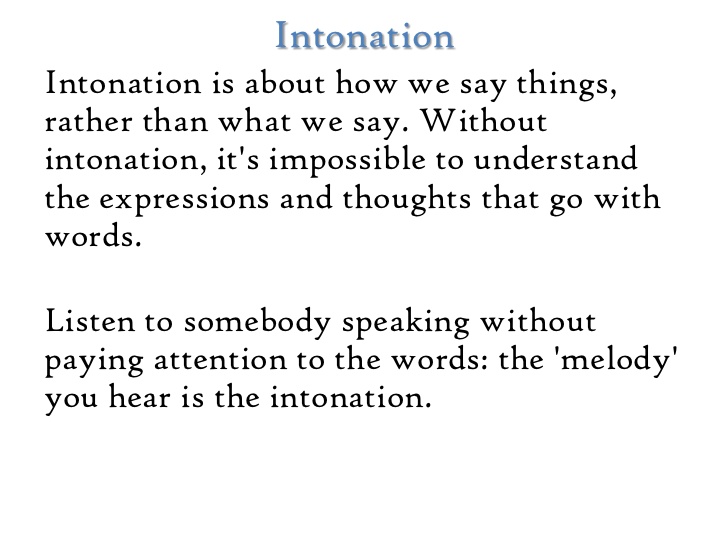
it is the rise or fall of the voice in speaking. Intonation helps us to show our feelings or attitude to what we are saying or to what someone else says. There are two main types of introduction in English falling tune and rising tune. The falling tune is often shown by the arrow(↘) while the rising tune is shown by the arrow (↗)
Intonation is the variation in the level of pitch in an utterance. When a person speaks, the pitch of his / her voice keeps changing. It may be high or low. Just as stress affects meaning in a sentence, intonation also affects meaning of an utterance because it carries the speaker’s attitude in the rise and fall in pitch of the speaker’s voice. It can also distinguish between an affirmative statement and an interrogative statement
e.g.
He is coming – affirmation
He is coming! – Exclamation / help.
The falling Tune: this is commonly used for statements, commands and questions that begin with words like where, what, when, how, which.
E.g.
Statements:
1. The boy won the prize.
2. John ate all the food.
3. The teacher beat the boy.
Command:
1. Kill the snake.
2. Write your homework.
3. Take your book.
Questions with Wh-words:
1. Where do you live?
2. Whose dress was stolen?
The rising tune : it is commonly used for yes/no questions, polite request, and listing.
E.g.
Yes/no questions:
1. Is he your friend?
2. Have you swept the room?
Polite requests:
1. Could you shut the door, please?
2. Will you serve the food, please?
Listing:
1. She was given a ruler, a pencil, a box of crayon.
2. He washed, dried, and ironed his clothes.
When we are listing items, the voice rises (rising tune) until we come to the last item and then the voice falls (falling tune)
https://youtu.be/FP4sNsEshHQ
Further Studies 2
STRESS:
To understand what is meant by stress, we explain syllable. Syllable is any of the unit which a word may be divided, usually consisting of a vowel sound with a consonant before or after it.
E.g
House,mouth,door------- one syllable
Cup-board, class-mate, ta-ble --------- two syllables
Im-por-tant, be-lie-ver, me-ta-phor---------- three syllables
e-lec-tri-ci-ty, ma-ni-pu-late-------------- four syllable
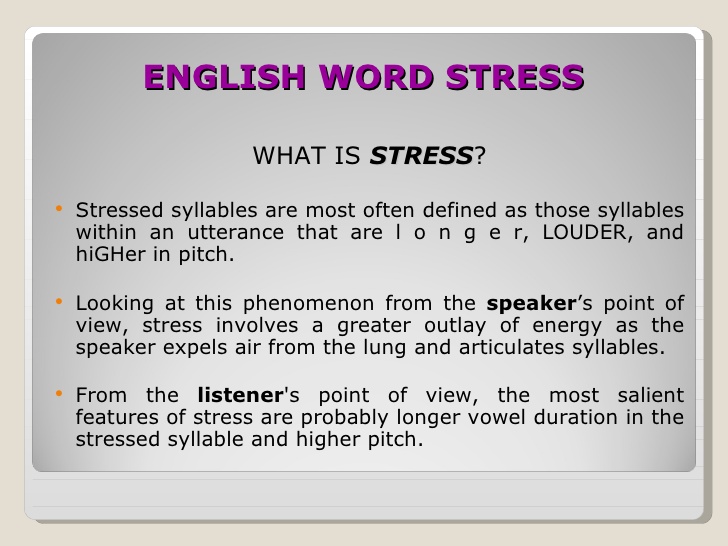
Stress is an extra force used when pronouncing a particular word or syllable. To stress a syllable is to make it more strongly to make it louder and prominent than the other syllables making up the word. The syllable that is pronounced strongest is known as the stressed syllable. It is represented by capital letter. E.g re-fu-GEE, un-der-STAND, PLEA-sure, sta-TE-gic, PO-si-ti-ve-lyetc .
https://youtu.be/Vu6UVwkUgzc
Some words of two syllables that function as noun and verb are stressed thus
NOUN VERB
IM-port im-PORT
EX-port ex-PORT
CON-duct con-DUCT
EX-cort ex-CORT
SUB-ject sub-JECT
The noun is stressed on the first syllable while the verb on the second syllable.
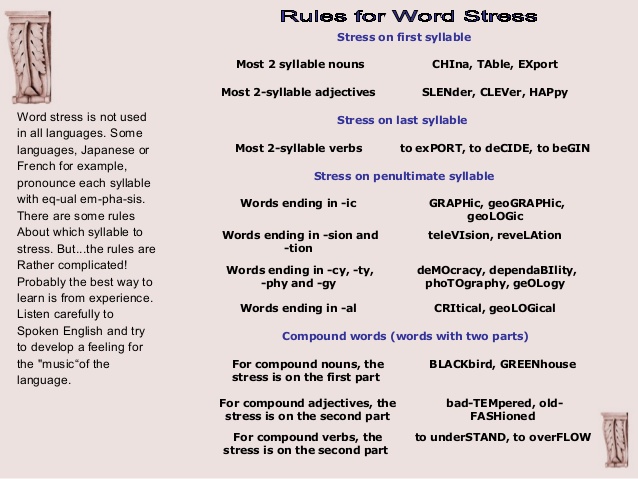
STRESS is the degree of prominence given to a particular syllable. It is the attention of loudness given to a syllable above other syllables. For instance in the word education that has four syllables, one of the four syllables will sound louder
than the others when pronounced and that syllable is called the stressed syllable.
We then have eduCAtion – stress on CA
i. e / kei /.
https://youtu.be/rnJCKda4oWU
(a) Placement: In normal s t r a i g h t f o r w a r d sentences or utterances, the following classes of words must be stressed: Nouns, Verbs, Adjective, most Adverbs, Numerals, Demonstratives (this, that) and Interjection.
The following classes of words are not stressed except for emphatic purposes: Auxiliary verbs, prepositions, conjunctions, personal pronouns, relative pronouns and Articles.
e.g. He came to the school yesterday.
He CAME to the SCHOOL YESTERDAY
(b) Shift: Stress does shift from one part of a word to another to make a clear distinction between two different classes of words having the same orthography (spelling) Examples of such words are as follows:
Noun---------Verb
CONduct-----conDUCT
Record------reCORD
Rebel-------reBEL
TORment-----torMENT
Extract-----exTRACT
OBJect------obJECTS
Export------exPORT
Minute------miNUTE
PROject-----proJECT
Insult------inSULT
CONtent-----conTENT
Attribute---attriBUTE
PROspect----prosPECT
CONvict-----conVICT etc.
(c) Emphatic: Emphatic stress is used on words of special importance to the user, even when such words are not be stressed normally. In the sentence – he came here yesterday, the normal
stress placement should be on CAME and YESTERDAY but I might choose to emphasize HE or HERE, leaving the real content words.
HE came here yesterday (not she)
He came HERE yesterday (not there)
He CAME here yesterday (not arrive)
He came here YESTERDAY (not today)
NB: Apart from the word that is stressed, every other part of the statement must retain the same information and any other word contrary to the one stressed in the options or which is not the correct question that is answered by the sentence above is the correct choice.
e.g. He came here YESTERDAY
(a) Did she come here today
(b) Did he come here yesterday
(c) Did he come here today
(d) Did he arrive here yesterday?
Option A will have been correct but because it has altered the information in the STEM by changing HE to SHE, it is not correct.
Option B: The STEM emphasizes YESTERDAY and B is the same, so it does not reflect the emphasis in its questioning.
Option D is guilty of the same error in addition to alteration of information by using ARRIVE instead of the original CAME.
D is therefore wrong. Option
C is correct because it is the right question for the answer given by the sentence with particular emphasis on YESTERDAY.
https://www.slideshare.net/aswanina/wor ... s-28875794
https://www.slideshare.net/satheesh985/ ... esentation
RHYTHM:
It is a strong, regular repeated pattern of sound. English is by nature a rhythmic language: there is rhythm in all spoken English, whether poetry, prose or simple conversation.
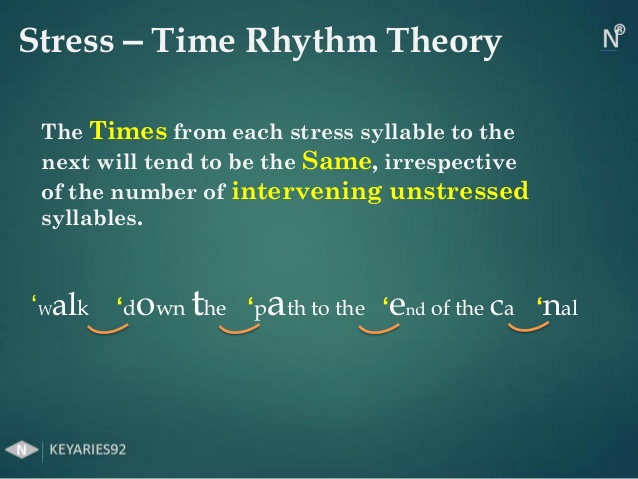
Many of those who use language well have a natural ear for rhythmic patterns: they know how to make the language sing. If we consider the great speeches of Winston Churchill, or Martin Luther King, we can see that one of the things that raise simple public speaking to the level of oratory is the ability of the speaker to use rhythmic devices to reinforce meaning and control the emotions of the audience.
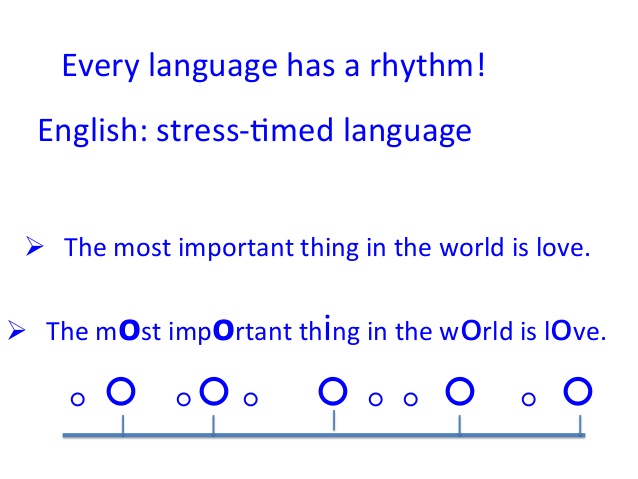
This, too, is what we as poets hope to do, whether we choose to use the traditional metrical forms or write in free verse. In order to do this better, it helps if we have an understanding of the nature of the language we are using.
http://www.slideshare.net/october1963/s ... intonation
LESSON 13
ASPECT: Grammar
TOPIC: Question Tag
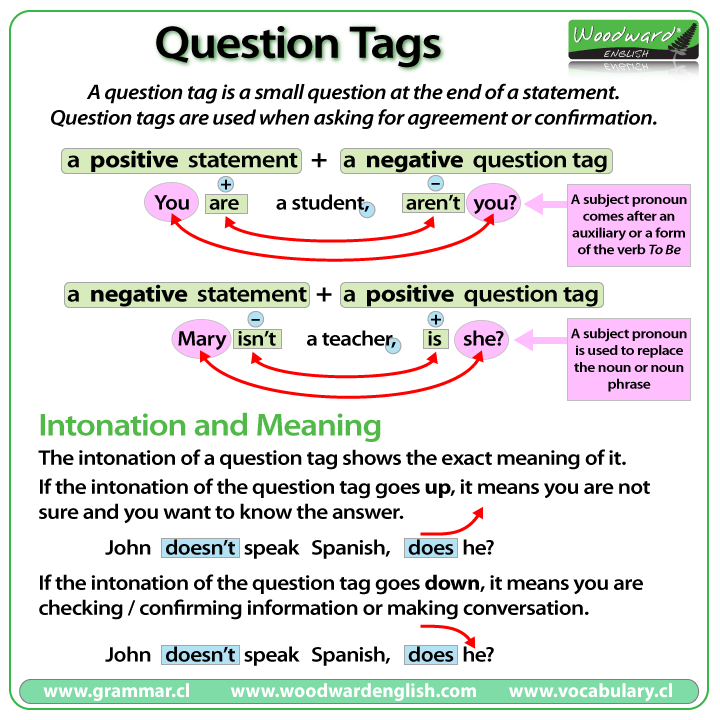
CONTENT:
These are usually a kind of Yes or No questions. They are attached (or tagged on) to the end of a statement. If the statement is positive the question tag will be negative and if the statement is negative the question tag will be positive. For example:
1. You are leaving now, aren’t?
2. You are not leaving now, are you?
3. The boys are not leaving yet, are they?
4. Sola took the book, didn’t she?
The subject of the verb in the statement is usually repeated in the tag.
She is here, isn’t she?
Use ‘It’ only when the subject being referred to is a little baby, an animal, an object or an abstract noun thus:
1. The dog has eaten its food, hasn’t?
2. My baby is sleeping, isn’t it?
3. A good idea is vital to progress, isn’t it?
4. The rain is heavy today, isn’t it?
Answer tag questions
1. You are leaving now, aren’t you?
No, I am not or yes, I am.
2. The dog has eaten its food, hasn’t it?
No, it hasn’t or yes, it has
3. My baby is sleeping, isn’t it?
Yes, it is or No, it isn’t
4. You bring them every day, don’t you?
Yes, I do or No, I don’t
https://www.slideshare.net/zulpiani/que ... s-27010123
EVALUATION:
Give a suitable statement to these question tag.
1. __________________, didn’t he?
2. __________________, will they?
Give a suitable tag to these statements.
1. They must be severely punished, _________?
2. Her baby is not eating well, ___________?
LESSON 14
ASPECT: Composition
TOPIC: Types of Features of Formal Letters
Content:
FORMAL / OFFICIAL / BUSINESS LETTERS
Conventions
(a) Addresses
(b) Date
(c) Salutation
(d) Subscription / Complimentary Close
(e) Signature.
1. Addresses: These include the heading and inside address.The heading/ writer's address and the inside/ addressee's address must be consistent in form (block or indented) and punctuation.
e.g
-----------------------------------------------------Pen-Write Private School,
-----------------------------------------------------29, Enitan Street,
-----------------------------------------------------Aguda,
-----------------------------------------------------Surulere,
-----------------------------------------------------Lagos.
-----------------------------------------------------8th June, 2002.
The Chairman,
Surulere Local Government,
Baruwa Area Office,
Ijeshatedo,
Lagos.
N.B: Put a comma after every number and at the end of every line of completed information. Then put a full stop at the end i.e. the last line.
2. Date: Date is written immediately below the writer's address to the right.
(a) Do not write October 7 for October 7th or 7th October.
(b) Do not use figures for month e.g. (7/10/2002).
(c) Do not abbreviate the year e.g. (June 15th, '88)
(d) Do not superscript the day e.g.(June 15th 2002)
(e) Always put a comma after the second item
e.g. (15th June, 2002 or June 15,2002)
(f) Do not include preposition in the date
e.g *15th of June, 2002.
(You can only use this in the body of the essay/letter)
3. Salutation: This is the same as greetings. It is written immediately below the addressee's address on the left side. A comma normally follows it. The salutation for a Formal Letter is:
e.g.
Dear Sir, OR Dear Madam, / Sir OR Madam, (where familiar) when the letter is addressed to a particular individual we can use the individual's name after Dear.
e.g.
Dear Mr. Mensah
Dear Dr. Smith
Dear Chief Giwa etc.
You may put the full stop after the abbreviations of Dr., Mr. etc or remove them.
4. Complimentary Close and Signature:
The closing of a Formal Letter should be placed on a separate line in the middle or to the right of the page.
Only the first letter of the complimentary close should be in capital and it must be followed by a comma before the signature and name, which is the surname and initials of the writer.
e.g. Yours faithfully, OR
Faithfully yours,
Yours truly, OR
Truly yours,
THE CONTENT:
The content of a formal letter follows a conventional pattern. Because such letters must be clear, direct as well as provide action, we limit our subject or topic to one per letter and write in short paragraphs.
The content of a Formal Letter is divided into three.
1. The Opening: In the 1st paragraph, we announce the subject or topic and attract the addressee's/receiver's attention. We acknowledge briefly any previous correspondence and state our response. The opening paragraph establishes the tone of the entire letter.
2. The Body: Here we supply the information required or requested, solve the problem, show evidence or logical reasoning for our suggestions, explain our decision and so on. The body of a formal letter consists of any pattern of ideas to accomplish our purpose. The audience and purpose determine the content and style.
3. The Closing: The last/closing paragraph suggests concrete action. We also affirm the position established in the first paragraph here in the last paragraph.
Formal letters are letters written on some official or business matter. Hence, they are known as official or business letters.
TYPES OF FORMAL LETTERS
1. Application for Employment.
2. Letter for Permission.
3. Letter of Apology.
4. Application for Admission to Educational institutions
5. Petitions to a Government office.
6. Letters of complaint to the police.
7. Letters of inquiry to a company.
8. Letter commenting on Editorials of Newspapers.
9. Applications for suppliers to manufacturing company.
10. Letter of Invitation.
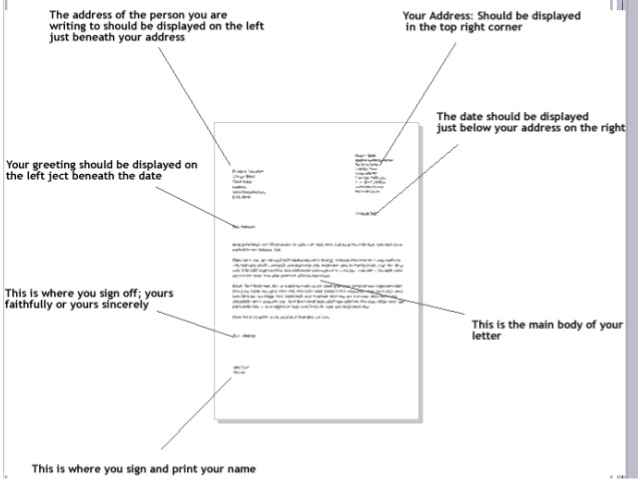
Features of Formal Letters
1. Address of the writer and Date.
2. The recipient’s official name(designation) and Date.
3. The Salutation.
4. The Subject heading.
5. The body of the letter.
6. The complimentary close or subscript.

EVALUATION
1. Mention 3 types of formal letters
2. Outline the features of a formal letter.
LESSON 15
ASPECT: Literature
TOPIC: Myth and Legend
Content:
Myth is a traditional story about heroes or supernatural beings, often attempting to explain the origins of natural phenomena or aspects of human behavior. It is widely held but mistaken belief. It is a widely held but mistaken belief. It is a narrative that through many retelling has become an accepted tradition in a society. It explains when the world began, how human being and animals came to being, how divine and human interact.

Legend: it is a story that has been passed down for generations, especially one that is presented as history but is unlikely to be true. They are traditional narratives or collections of related narratives, regarded as historical fact but are a mixture of fact and fiction. They arebelieved by both narrators by both narrator and audience; it covers a variety of subject: saints, wolves, ghosts and other supernatural creatures, adventures of real heroes and heroine.

Further Studies
EVALUATION:
1. Explain the concept myth?
2. What is legend?
Fill in the gap in each of the following with the best option from the alternatives lettered A-E.
1. That that was honest, --------?
a. Was he? B. could he? C. wasn’t he? D. can he? E. not so?
2. The man is a cook, isn’t he? -------------
a. Yes, he isn’t b. yes, he aren’t c. no, he wasn’t d. yes, he is e. no, he is
3. You are ready, ------ you? A. are b. aren’t c. do d. were e. weren’t
4. Audu did not borrow the book, ----------- he? A. did b. didn,t c. does d. hasn’t e. was
5. The man did not give you the money, did he? A. no, he didn’t b.no, he did c. yes, he did d. yes, he wase. yes, he was
ASPECT: COMPREHENSION
TITLE: EZINMA

Another name for story is a narrative. A fiction is a narrative. History –the story of the events of the past –can be a narrative .Biography is the story of a person’s life written by another person .It is also a narrative .Auto-biography is the story of a person’s life written by himself. A narrative uses figure of speech to make word picture eg ‘just like’ ‘as’ ‘similar to’ we call that simile.

EVALUATION: Intensive English Book 2;Exercises 3.2.2 and 3.2.3; pages 26-28.
ASSIGNMENT: Intensive English Book 2;Exercises 3. 2.4, 3.2.5, and 3.3.5; pages 28-34.
LESSON 12
TOPIC: SPEECH WORK
SUB-TOPIC:INTONATION, STRESS AND RHYTHM
CONTENT:
Intonation:

it is the rise or fall of the voice in speaking. Intonation helps us to show our feelings or attitude to what we are saying or to what someone else says. There are two main types of introduction in English falling tune and rising tune. The falling tune is often shown by the arrow(↘) while the rising tune is shown by the arrow (↗)
Intonation is the variation in the level of pitch in an utterance. When a person speaks, the pitch of his / her voice keeps changing. It may be high or low. Just as stress affects meaning in a sentence, intonation also affects meaning of an utterance because it carries the speaker’s attitude in the rise and fall in pitch of the speaker’s voice. It can also distinguish between an affirmative statement and an interrogative statement
e.g.
He is coming – affirmation
He is coming! – Exclamation / help.
The falling Tune: this is commonly used for statements, commands and questions that begin with words like where, what, when, how, which.
E.g.
Statements:
1. The boy won the prize.
2. John ate all the food.
3. The teacher beat the boy.
Command:
1. Kill the snake.
2. Write your homework.
3. Take your book.
Questions with Wh-words:
1. Where do you live?
2. Whose dress was stolen?
The rising tune : it is commonly used for yes/no questions, polite request, and listing.
E.g.
Yes/no questions:
1. Is he your friend?
2. Have you swept the room?
Polite requests:
1. Could you shut the door, please?
2. Will you serve the food, please?
Listing:
1. She was given a ruler, a pencil, a box of crayon.
2. He washed, dried, and ironed his clothes.
When we are listing items, the voice rises (rising tune) until we come to the last item and then the voice falls (falling tune)
https://youtu.be/FP4sNsEshHQ
Further Studies 2
STRESS:
To understand what is meant by stress, we explain syllable. Syllable is any of the unit which a word may be divided, usually consisting of a vowel sound with a consonant before or after it.
E.g
House,mouth,door------- one syllable
Cup-board, class-mate, ta-ble --------- two syllables
Im-por-tant, be-lie-ver, me-ta-phor---------- three syllables
e-lec-tri-ci-ty, ma-ni-pu-late-------------- four syllable

Stress is an extra force used when pronouncing a particular word or syllable. To stress a syllable is to make it more strongly to make it louder and prominent than the other syllables making up the word. The syllable that is pronounced strongest is known as the stressed syllable. It is represented by capital letter. E.g re-fu-GEE, un-der-STAND, PLEA-sure, sta-TE-gic, PO-si-ti-ve-lyetc .
https://youtu.be/Vu6UVwkUgzc
Some words of two syllables that function as noun and verb are stressed thus
NOUN VERB
IM-port im-PORT
EX-port ex-PORT
CON-duct con-DUCT
EX-cort ex-CORT
SUB-ject sub-JECT
The noun is stressed on the first syllable while the verb on the second syllable.

STRESS is the degree of prominence given to a particular syllable. It is the attention of loudness given to a syllable above other syllables. For instance in the word education that has four syllables, one of the four syllables will sound louder
than the others when pronounced and that syllable is called the stressed syllable.
We then have eduCAtion – stress on CA
i. e / kei /.
https://youtu.be/rnJCKda4oWU
(a) Placement: In normal s t r a i g h t f o r w a r d sentences or utterances, the following classes of words must be stressed: Nouns, Verbs, Adjective, most Adverbs, Numerals, Demonstratives (this, that) and Interjection.
The following classes of words are not stressed except for emphatic purposes: Auxiliary verbs, prepositions, conjunctions, personal pronouns, relative pronouns and Articles.
e.g. He came to the school yesterday.
He CAME to the SCHOOL YESTERDAY
(b) Shift: Stress does shift from one part of a word to another to make a clear distinction between two different classes of words having the same orthography (spelling) Examples of such words are as follows:
Noun---------Verb
CONduct-----conDUCT
Record------reCORD
Rebel-------reBEL
TORment-----torMENT
Extract-----exTRACT
OBJect------obJECTS
Export------exPORT
Minute------miNUTE
PROject-----proJECT
Insult------inSULT
CONtent-----conTENT
Attribute---attriBUTE
PROspect----prosPECT
CONvict-----conVICT etc.
(c) Emphatic: Emphatic stress is used on words of special importance to the user, even when such words are not be stressed normally. In the sentence – he came here yesterday, the normal
stress placement should be on CAME and YESTERDAY but I might choose to emphasize HE or HERE, leaving the real content words.
HE came here yesterday (not she)
He came HERE yesterday (not there)
He CAME here yesterday (not arrive)
He came here YESTERDAY (not today)
NB: Apart from the word that is stressed, every other part of the statement must retain the same information and any other word contrary to the one stressed in the options or which is not the correct question that is answered by the sentence above is the correct choice.
e.g. He came here YESTERDAY
(a) Did she come here today
(b) Did he come here yesterday
(c) Did he come here today
(d) Did he arrive here yesterday?
Option A will have been correct but because it has altered the information in the STEM by changing HE to SHE, it is not correct.
Option B: The STEM emphasizes YESTERDAY and B is the same, so it does not reflect the emphasis in its questioning.
Option D is guilty of the same error in addition to alteration of information by using ARRIVE instead of the original CAME.
D is therefore wrong. Option
C is correct because it is the right question for the answer given by the sentence with particular emphasis on YESTERDAY.
https://www.slideshare.net/aswanina/wor ... s-28875794
https://www.slideshare.net/satheesh985/ ... esentation
RHYTHM:
It is a strong, regular repeated pattern of sound. English is by nature a rhythmic language: there is rhythm in all spoken English, whether poetry, prose or simple conversation.

Many of those who use language well have a natural ear for rhythmic patterns: they know how to make the language sing. If we consider the great speeches of Winston Churchill, or Martin Luther King, we can see that one of the things that raise simple public speaking to the level of oratory is the ability of the speaker to use rhythmic devices to reinforce meaning and control the emotions of the audience.

This, too, is what we as poets hope to do, whether we choose to use the traditional metrical forms or write in free verse. In order to do this better, it helps if we have an understanding of the nature of the language we are using.
http://www.slideshare.net/october1963/s ... intonation
LESSON 13
ASPECT: Grammar
TOPIC: Question Tag

CONTENT:
These are usually a kind of Yes or No questions. They are attached (or tagged on) to the end of a statement. If the statement is positive the question tag will be negative and if the statement is negative the question tag will be positive. For example:
1. You are leaving now, aren’t?
2. You are not leaving now, are you?
3. The boys are not leaving yet, are they?
4. Sola took the book, didn’t she?
The subject of the verb in the statement is usually repeated in the tag.
She is here, isn’t she?
Use ‘It’ only when the subject being referred to is a little baby, an animal, an object or an abstract noun thus:
1. The dog has eaten its food, hasn’t?
2. My baby is sleeping, isn’t it?
3. A good idea is vital to progress, isn’t it?
4. The rain is heavy today, isn’t it?
Answer tag questions
1. You are leaving now, aren’t you?
No, I am not or yes, I am.
2. The dog has eaten its food, hasn’t it?
No, it hasn’t or yes, it has
3. My baby is sleeping, isn’t it?
Yes, it is or No, it isn’t
4. You bring them every day, don’t you?
Yes, I do or No, I don’t
https://www.slideshare.net/zulpiani/que ... s-27010123
EVALUATION:
Give a suitable statement to these question tag.
1. __________________, didn’t he?
2. __________________, will they?
Give a suitable tag to these statements.
1. They must be severely punished, _________?
2. Her baby is not eating well, ___________?
LESSON 14
ASPECT: Composition
TOPIC: Types of Features of Formal Letters
Content:
FORMAL / OFFICIAL / BUSINESS LETTERS
Conventions
(a) Addresses
(b) Date
(c) Salutation
(d) Subscription / Complimentary Close
(e) Signature.
1. Addresses: These include the heading and inside address.The heading/ writer's address and the inside/ addressee's address must be consistent in form (block or indented) and punctuation.
e.g
-----------------------------------------------------Pen-Write Private School,
-----------------------------------------------------29, Enitan Street,
-----------------------------------------------------Aguda,
-----------------------------------------------------Surulere,
-----------------------------------------------------Lagos.
-----------------------------------------------------8th June, 2002.
The Chairman,
Surulere Local Government,
Baruwa Area Office,
Ijeshatedo,
Lagos.
N.B: Put a comma after every number and at the end of every line of completed information. Then put a full stop at the end i.e. the last line.
2. Date: Date is written immediately below the writer's address to the right.
(a) Do not write October 7 for October 7th or 7th October.
(b) Do not use figures for month e.g. (7/10/2002).
(c) Do not abbreviate the year e.g. (June 15th, '88)
(d) Do not superscript the day e.g.(June 15th 2002)
(e) Always put a comma after the second item
e.g. (15th June, 2002 or June 15,2002)
(f) Do not include preposition in the date
e.g *15th of June, 2002.
(You can only use this in the body of the essay/letter)
3. Salutation: This is the same as greetings. It is written immediately below the addressee's address on the left side. A comma normally follows it. The salutation for a Formal Letter is:
e.g.
Dear Sir, OR Dear Madam, / Sir OR Madam, (where familiar) when the letter is addressed to a particular individual we can use the individual's name after Dear.
e.g.
Dear Mr. Mensah
Dear Dr. Smith
Dear Chief Giwa etc.
You may put the full stop after the abbreviations of Dr., Mr. etc or remove them.
4. Complimentary Close and Signature:
The closing of a Formal Letter should be placed on a separate line in the middle or to the right of the page.
Only the first letter of the complimentary close should be in capital and it must be followed by a comma before the signature and name, which is the surname and initials of the writer.
e.g. Yours faithfully, OR
Faithfully yours,
Yours truly, OR
Truly yours,
THE CONTENT:
The content of a formal letter follows a conventional pattern. Because such letters must be clear, direct as well as provide action, we limit our subject or topic to one per letter and write in short paragraphs.
The content of a Formal Letter is divided into three.
1. The Opening: In the 1st paragraph, we announce the subject or topic and attract the addressee's/receiver's attention. We acknowledge briefly any previous correspondence and state our response. The opening paragraph establishes the tone of the entire letter.
2. The Body: Here we supply the information required or requested, solve the problem, show evidence or logical reasoning for our suggestions, explain our decision and so on. The body of a formal letter consists of any pattern of ideas to accomplish our purpose. The audience and purpose determine the content and style.
3. The Closing: The last/closing paragraph suggests concrete action. We also affirm the position established in the first paragraph here in the last paragraph.
Formal letters are letters written on some official or business matter. Hence, they are known as official or business letters.
TYPES OF FORMAL LETTERS
1. Application for Employment.
2. Letter for Permission.
3. Letter of Apology.
4. Application for Admission to Educational institutions
5. Petitions to a Government office.
6. Letters of complaint to the police.
7. Letters of inquiry to a company.
8. Letter commenting on Editorials of Newspapers.
9. Applications for suppliers to manufacturing company.
10. Letter of Invitation.

Features of Formal Letters
1. Address of the writer and Date.
2. The recipient’s official name(designation) and Date.
3. The Salutation.
4. The Subject heading.
5. The body of the letter.
6. The complimentary close or subscript.

EVALUATION
1. Mention 3 types of formal letters
2. Outline the features of a formal letter.
LESSON 15
ASPECT: Literature
TOPIC: Myth and Legend
Content:
Myth is a traditional story about heroes or supernatural beings, often attempting to explain the origins of natural phenomena or aspects of human behavior. It is widely held but mistaken belief. It is a widely held but mistaken belief. It is a narrative that through many retelling has become an accepted tradition in a society. It explains when the world began, how human being and animals came to being, how divine and human interact.

Legend: it is a story that has been passed down for generations, especially one that is presented as history but is unlikely to be true. They are traditional narratives or collections of related narratives, regarded as historical fact but are a mixture of fact and fiction. They arebelieved by both narrators by both narrator and audience; it covers a variety of subject: saints, wolves, ghosts and other supernatural creatures, adventures of real heroes and heroine.

Further Studies
EVALUATION:
1. Explain the concept myth?
2. What is legend?
Fill in the gap in each of the following with the best option from the alternatives lettered A-E.
1. That that was honest, --------?
a. Was he? B. could he? C. wasn’t he? D. can he? E. not so?
2. The man is a cook, isn’t he? -------------
a. Yes, he isn’t b. yes, he aren’t c. no, he wasn’t d. yes, he is e. no, he is
3. You are ready, ------ you? A. are b. aren’t c. do d. were e. weren’t
4. Audu did not borrow the book, ----------- he? A. did b. didn,t c. does d. hasn’t e. was
5. The man did not give you the money, did he? A. no, he didn’t b.no, he did c. yes, he did d. yes, he wase. yes, he was
WEEK 4
LESSON 16
MAIN TOPIC: Nasal Sounds
SPECIFIC TOPIC: Sounds /m/, /n/
REFERENCE BOOKS: The Best of Oral English
PERFORMANCE OBJECTIVES: At the end of the lesson the students should be able to:
i. Pronounce words in which the sounds /m/, /n/ occur correctly
ii. Read sentences in which /m/ and /n/ occur
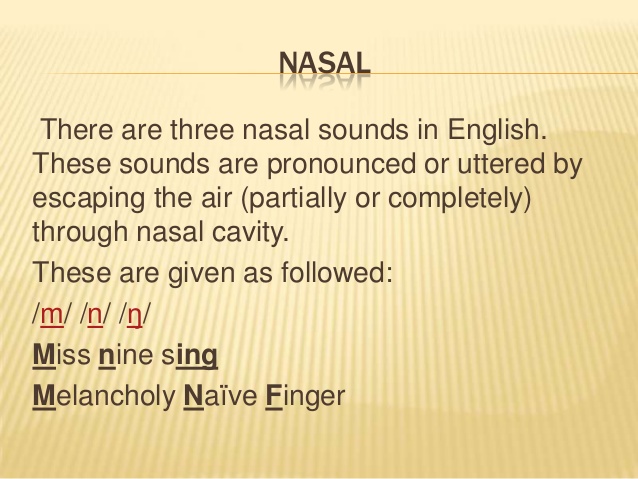
CONTENT:
Sounds /m/ and /n/ are nasal sounds. Words in which sound /m/ and /n/ occur are:
/m/ - man, met, meet, teem, name, milk, much, make, same etc.
/n/ - net, need, ten, name, nod, knot, nob, burn, sane, tan etc.
https://youtu.be/_o7H0eoj2SI
Sentences: Ten men were given milk
Our team won the match
Much work was done.
https://youtu.be/vDrdgvk-G30
EVALUATION:
i. Pronounce the following words:
Man, name, knot, small
ii. Read the sentences above (in the content)
ASSIGNMENT
Mention 5 more words that have the sound /m/ and 5 more words that have/n/ in them.
LESSON 17
ASPECT: COMPREHENSION
TOPIC: The Letter Writer
The people in a narrative are caIIed the characters. Characterization is an important element in any story or play. Look out for the writer’s description of the characters and for the dialogue they engaged with each other. These will give the nature of the characters in the play.
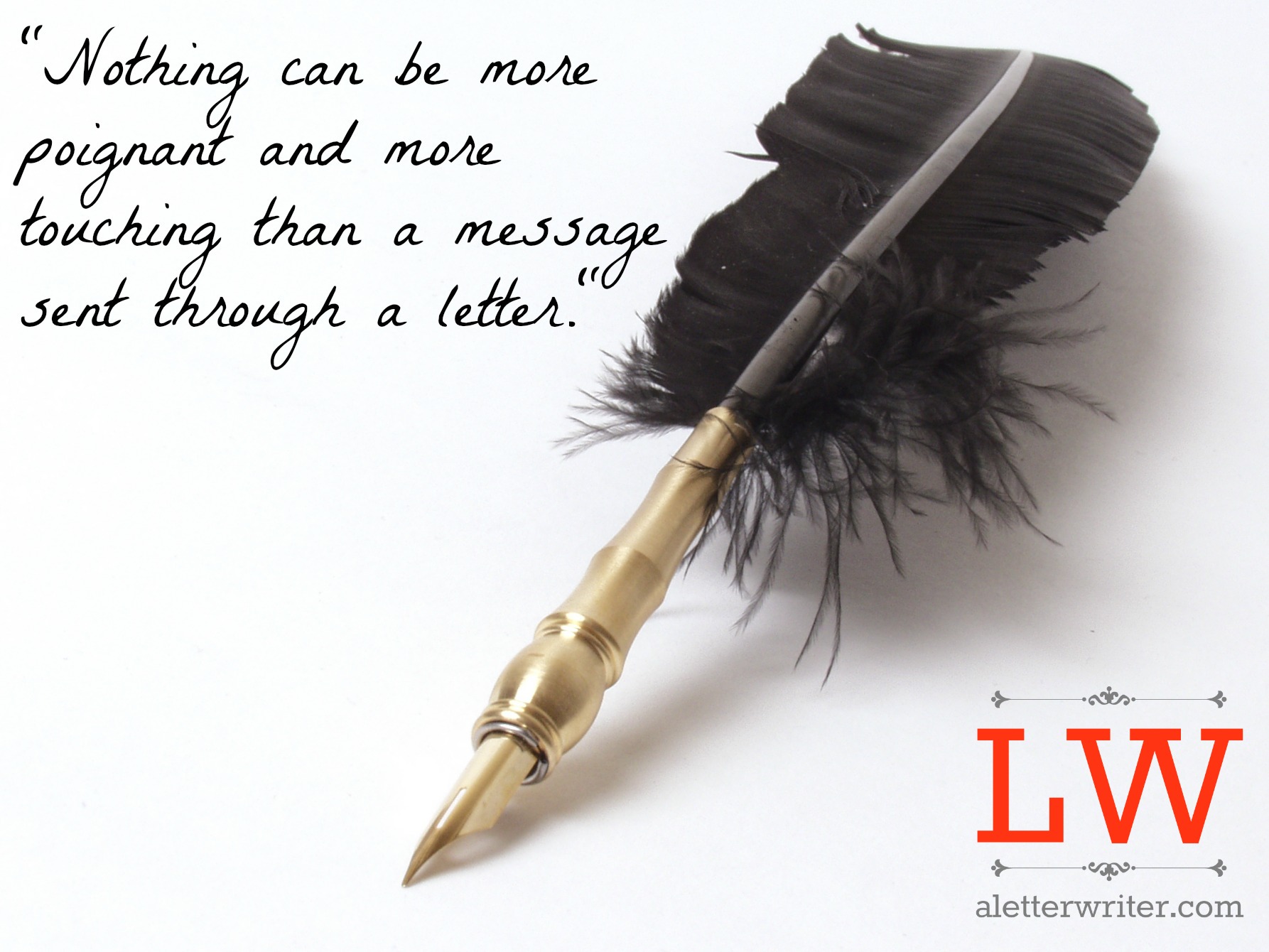
EVALUATION:Intensive English Book 2; Exercise 4.2.2 and 4.2.3; pages 38-39.
ASSIGNMENT:Intensive English Book 2; Exercise 4. 2.4, 4.2.5, and 4.3.5; pages 39-46.
LESSON 18
ASPECT: SPEECH WORK
TOPIC: CONTRASTING VOWELS/i:/ AND /I/; /u:/ AND /Ʊ/
CONTENT:
Long and short vowel contrasting./i:/ and /I/, /u:/ and /Ʊ/
/i:/.............../i/....................../u:/............/Ʊ/
beans............bins......................fool............full
wheel............will......................pool...........pull
wheat............wit......................food...........foot
beat..............bit......................cooled.........could
seat...............sit......................hood..........hewed
feet...............fit.....................wooed.........wood
/i:/
ee----ea-----e--------i
free--meat—-peter--margarine
bee---sea---we-----machine
tree--beat—-he-----police
need--leaf—-these--kerosine
ie-----ei-----ey-----uay
chief—-seize—-key----Quay
field--receive
thief--deceive
piece--ceiling
/I/
i------y-------e--------ie-------a
sit----nymph—--pretty---ladies---village
fifth—-rhythm—-wicked—--cities--private
rich---symbol—-careless-parties--manage
trick—-lynx----houses---carries--savage
https://youtu.be/gme2kr9hhXg
/u/
u----ou----o----oo
put could wolf good
full should woman book
sugar would wool food
/u:/
o---oo----u---ou
do food rude group
who soon tune soup
move moon June through
ew---ue----ui----oe
chew blue juice shoe
stew sue suit
drew true fruit
https://youtu.be/elJQ2Cm27rQ
Pronunciation Practice
https://www.youtube.com/watch?v=2bENWqwYLxU
LESSON 19
ASPECT: Grammar
TOPIC: Active and Passive Voice

CONTENT:
A verb is said to be in the Active Voice when the subject performs the action described by the verb.
E.g.
Paul wrote a letter.
“Paul” is the subject. That is, the performer of the action “wrote”. ”wrote” is the Active Voice since the subject of the verb “Paul” is doing the writing.
Passive Voice: when the object of a sentence takes the place of the subject and the subject is placed in the position of the object while the verb “be” is used with the past participle, then the verb is said to be in the Passive Voice. In order words, when the subject receives the action described by the verb, then the verb is in the Passive Voice.
Mary was slapped by her mother.
“Mary” is the receiver of the action ”slap” and so “slap” is in the passive voice.
1. I saw Paul (Active)
2. Paul was seen by me.(Passive)
3. We ate some mangoes.(Active)
4. Some mangoes were eaten by us.(Passive)
The following changes usually occur while writing the passive voice,
Active Passive
I me
He him
She her
We us
They them
The subject pronoun changes to object pronoun
Active Passive
saw seen
ate eaten
wrote written
drove driven
sang sung
The past tense verb changes to past perfect tense
EVALUATION: Change the following sentences from active into passive.
1. My mother prepared a pot of stew.
2. We sang a new song.
3. The teacher gave us some difficult sums.
4. A dog bit the woman.
ASSIGNMENT: Change the following passive sentences into the related active sentences.
1. It was broken carelessly by her.
2. Water was brought to the workers in the morning by Chinyere.
3. The bottle was broken by him.
4. Smaller cars are preferred by ladies
5. The song are sung by them.
Further Studies 1
Further Studies 2
LESSON 20
ASPECT: Composition
TOPIC: Summary Writing
CONTENT:

A summary is an aspect of writing that requires the shortened version of a longer piece of writing. It is also a way of trying to represent accurately but in a reduced manner, important points in an original piece of spoken or written material.
EVALUATION: Rewrite the story “Naked Truth is out About New Worker” in 80 words. Junior English Project for JSS2 page 76-79, no 5
Further Studies
LESSON 21
ASPECT: Literature
TOPIC: Oral Literature
CONTENT:
Oral literature also known as orature may be in prose or verse. The prose is often mythological or historical and can include tales of the trickster character.
Folk literature, also called folklore or oral tradition, the lore (traditional knowledge and beliefs) of cultures having no written language. It is transmitted by word of mouth and consists, as does written literature, of both prose and verse narratives, poems and songs, myths, dramas, rituals, proverbs, riddles, and the like. Nearly all known peoples, now or in the past, have produced it.
Anansi Goes Fishing (A Tale from West Africa)
Foolish Anansi thought he could trick a fisherman into doing his work for him. "Let's go fishing," he suggested.
"Very well," said the fisherman, who was clever and quite wise to Anansi's tricks. "I'll make the nets and you can get tired for me."
"Wait," said Anansi, "I'll make the nets and you can get tired for me!" Anansi made nets as his friend pretended to be tired. They caught four fish.
The fisherman said, "Anansi, you take these. I'll take tomorrow's catch. It might be bigger."
Greedily imagining the next day's catch, Anansi said, "No, you take these and I'll take tomorrow's fish."
But the next day, the nets were rotting away and no fish were caught. The fisherman said, "Anansi, take these rotten nets to market. You can sell them for much money." When Anansi shouted, "Rotten nets for sale!" in the marketplace, people beat him with sticks.
"Some partner you are," Anansi said to the fisherman as he rubbed his bruises. "I took the beatings. At least you could have taken the pain." Anansi never tried to trick the fisherman again!
https://www.youtube.com/watch?v=WLb9oBTjK3c
MAIN TOPIC: Nasal Sounds
SPECIFIC TOPIC: Sounds /m/, /n/
REFERENCE BOOKS: The Best of Oral English
PERFORMANCE OBJECTIVES: At the end of the lesson the students should be able to:
i. Pronounce words in which the sounds /m/, /n/ occur correctly
ii. Read sentences in which /m/ and /n/ occur

CONTENT:
Sounds /m/ and /n/ are nasal sounds. Words in which sound /m/ and /n/ occur are:
/m/ - man, met, meet, teem, name, milk, much, make, same etc.
/n/ - net, need, ten, name, nod, knot, nob, burn, sane, tan etc.
https://youtu.be/_o7H0eoj2SI
Sentences: Ten men were given milk
Our team won the match
Much work was done.
https://youtu.be/vDrdgvk-G30
EVALUATION:
i. Pronounce the following words:
Man, name, knot, small
ii. Read the sentences above (in the content)
ASSIGNMENT
Mention 5 more words that have the sound /m/ and 5 more words that have/n/ in them.
LESSON 17
ASPECT: COMPREHENSION
TOPIC: The Letter Writer
The people in a narrative are caIIed the characters. Characterization is an important element in any story or play. Look out for the writer’s description of the characters and for the dialogue they engaged with each other. These will give the nature of the characters in the play.

EVALUATION:Intensive English Book 2; Exercise 4.2.2 and 4.2.3; pages 38-39.
ASSIGNMENT:Intensive English Book 2; Exercise 4. 2.4, 4.2.5, and 4.3.5; pages 39-46.
LESSON 18
ASPECT: SPEECH WORK
TOPIC: CONTRASTING VOWELS/i:/ AND /I/; /u:/ AND /Ʊ/
CONTENT:
Long and short vowel contrasting./i:/ and /I/, /u:/ and /Ʊ/
/i:/.............../i/....................../u:/............/Ʊ/
beans............bins......................fool............full
wheel............will......................pool...........pull
wheat............wit......................food...........foot
beat..............bit......................cooled.........could
seat...............sit......................hood..........hewed
feet...............fit.....................wooed.........wood
/i:/
ee----ea-----e--------i
free--meat—-peter--margarine
bee---sea---we-----machine
tree--beat—-he-----police
need--leaf—-these--kerosine
ie-----ei-----ey-----uay
chief—-seize—-key----Quay
field--receive
thief--deceive
piece--ceiling
/I/
i------y-------e--------ie-------a
sit----nymph—--pretty---ladies---village
fifth—-rhythm—-wicked—--cities--private
rich---symbol—-careless-parties--manage
trick—-lynx----houses---carries--savage
https://youtu.be/gme2kr9hhXg
/u/
u----ou----o----oo
put could wolf good
full should woman book
sugar would wool food
/u:/
o---oo----u---ou
do food rude group
who soon tune soup
move moon June through
ew---ue----ui----oe
chew blue juice shoe
stew sue suit
drew true fruit
https://youtu.be/elJQ2Cm27rQ
Pronunciation Practice
https://www.youtube.com/watch?v=2bENWqwYLxU
LESSON 19
ASPECT: Grammar
TOPIC: Active and Passive Voice

CONTENT:
A verb is said to be in the Active Voice when the subject performs the action described by the verb.
E.g.
Paul wrote a letter.
“Paul” is the subject. That is, the performer of the action “wrote”. ”wrote” is the Active Voice since the subject of the verb “Paul” is doing the writing.
Passive Voice: when the object of a sentence takes the place of the subject and the subject is placed in the position of the object while the verb “be” is used with the past participle, then the verb is said to be in the Passive Voice. In order words, when the subject receives the action described by the verb, then the verb is in the Passive Voice.
Mary was slapped by her mother.
“Mary” is the receiver of the action ”slap” and so “slap” is in the passive voice.
1. I saw Paul (Active)
2. Paul was seen by me.(Passive)
3. We ate some mangoes.(Active)
4. Some mangoes were eaten by us.(Passive)
The following changes usually occur while writing the passive voice,
Active Passive
I me
He him
She her
We us
They them
The subject pronoun changes to object pronoun
Active Passive
saw seen
ate eaten
wrote written
drove driven
sang sung
The past tense verb changes to past perfect tense
EVALUATION: Change the following sentences from active into passive.
1. My mother prepared a pot of stew.
2. We sang a new song.
3. The teacher gave us some difficult sums.
4. A dog bit the woman.
ASSIGNMENT: Change the following passive sentences into the related active sentences.
1. It was broken carelessly by her.
2. Water was brought to the workers in the morning by Chinyere.
3. The bottle was broken by him.
4. Smaller cars are preferred by ladies
5. The song are sung by them.
Further Studies 1
Further Studies 2
LESSON 20
ASPECT: Composition
TOPIC: Summary Writing
CONTENT:

A summary is an aspect of writing that requires the shortened version of a longer piece of writing. It is also a way of trying to represent accurately but in a reduced manner, important points in an original piece of spoken or written material.
EVALUATION: Rewrite the story “Naked Truth is out About New Worker” in 80 words. Junior English Project for JSS2 page 76-79, no 5
Further Studies
LESSON 21
ASPECT: Literature
TOPIC: Oral Literature
CONTENT:
Oral literature also known as orature may be in prose or verse. The prose is often mythological or historical and can include tales of the trickster character.
Folk literature, also called folklore or oral tradition, the lore (traditional knowledge and beliefs) of cultures having no written language. It is transmitted by word of mouth and consists, as does written literature, of both prose and verse narratives, poems and songs, myths, dramas, rituals, proverbs, riddles, and the like. Nearly all known peoples, now or in the past, have produced it.
Anansi Goes Fishing (A Tale from West Africa)
Foolish Anansi thought he could trick a fisherman into doing his work for him. "Let's go fishing," he suggested.
"Very well," said the fisherman, who was clever and quite wise to Anansi's tricks. "I'll make the nets and you can get tired for me."
"Wait," said Anansi, "I'll make the nets and you can get tired for me!" Anansi made nets as his friend pretended to be tired. They caught four fish.
The fisherman said, "Anansi, you take these. I'll take tomorrow's catch. It might be bigger."
Greedily imagining the next day's catch, Anansi said, "No, you take these and I'll take tomorrow's fish."
But the next day, the nets were rotting away and no fish were caught. The fisherman said, "Anansi, take these rotten nets to market. You can sell them for much money." When Anansi shouted, "Rotten nets for sale!" in the marketplace, people beat him with sticks.
"Some partner you are," Anansi said to the fisherman as he rubbed his bruises. "I took the beatings. At least you could have taken the pain." Anansi never tried to trick the fisherman again!
https://www.youtube.com/watch?v=WLb9oBTjK3c
WEEK 6
LESSON 22
ASPECT: COMPREHENSION
TOPIC: Voting
When you read, evaluate carefully the opinions expressed by the writer. An opinion is a belief not based on absolute certainty or positive knowledge but on what seems true or probable to someone. In this passage, the writer’s purpose is to express opinions in order to inform and to persuade us .You are free to agree or disagree with the opinions expressed.

EVALUATION: Intensive English Book 2; Exercises 5.2.2 and 5.2.3; Page 50.
ASSIGNMENT: Intensive English Book 2; Exercises 5. 2.4, 5.2.5 and 5.3.5; pages 51-56.
LESSON 23
ASPECT: Speech Work
TOPIC: Consonant /s/, /z/, /ð/,/Ɵ/
CONTENT:
/s/, /z/ and /ð/ are consonant sounds./s/ is a voiceless alveolar fricative while /z/ is a voiced alveolar fricative.
/ð/ and /Ɵ/are called “th” sound.
/Ɵ/ is voiceless fricative while /ð/ is a voiced fricative.
Word examples of /s/, /z/ and /Ɵ//
/s/- sank, pass, salt,
/z/- breeze, sues, lays
/ð/- the, that, leather, with, breathe, father, mother, clothes,soothe, there etc.
/Ɵ/ - thank, thin, think, thought, path, breath, cloth, third, north, health, earth.
/s/
c---------s--------ss-------ps--------sw------sc
cell------sing boss psalm sword scissors
concert---fuse gossip pseudopodia science
parcel----gospel class psychology scene
There are some silent s which are not /s/ such as Island, Isle and aisle
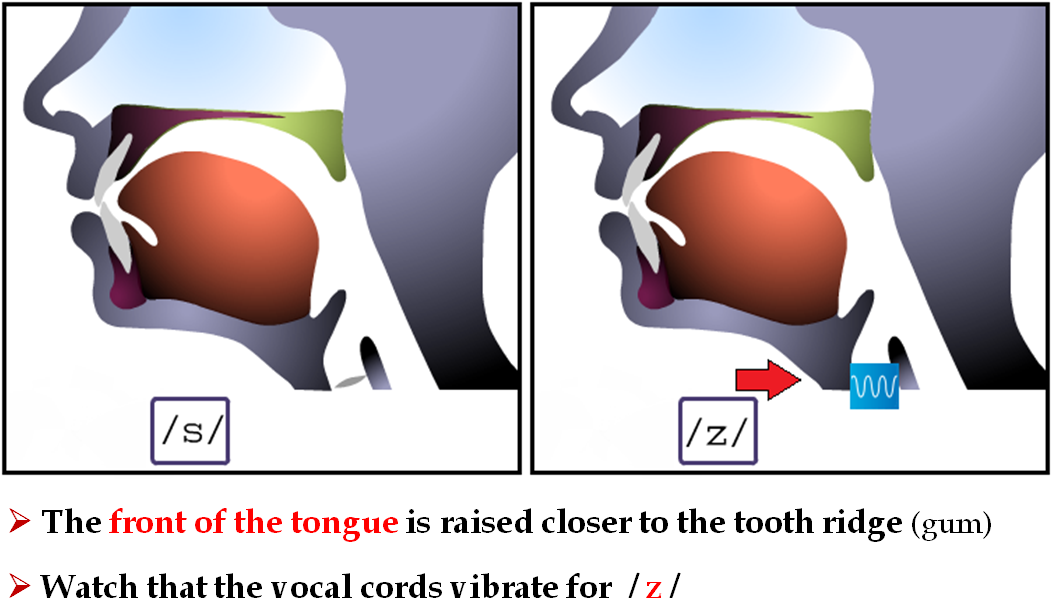
/z/
z-------s-----ss
zebra—--present--assume
zoo-----raise----assumption
amazing-twins
azure---boys
zip-----rose
https://youtu.be/HJlpuAyZzWk
/θ /
th
think
method
anthem
bath
teeth
mathematics
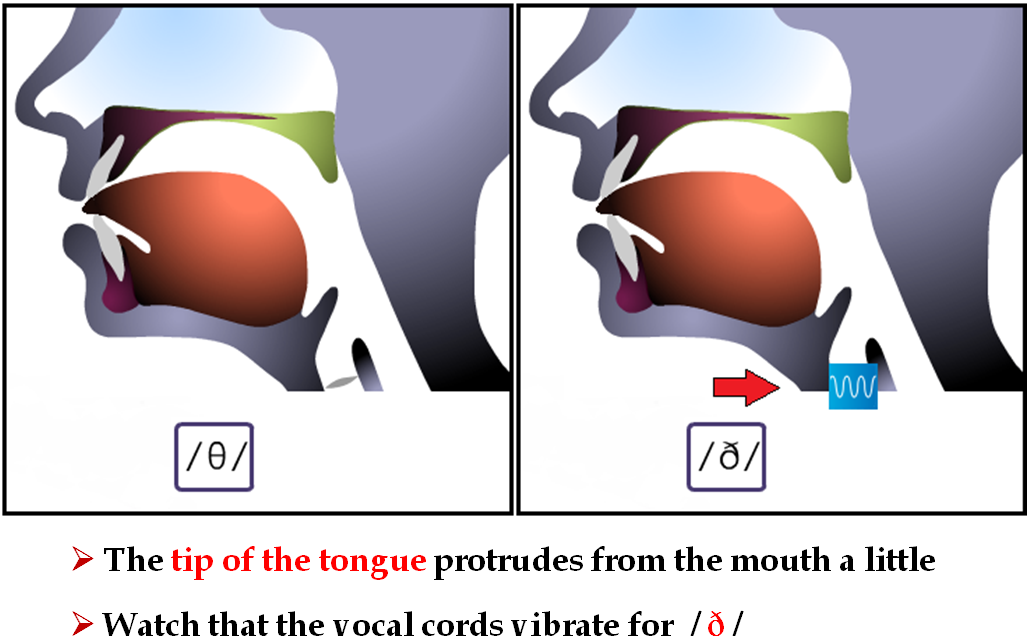
https://youtu.be/X-J-rv7JXL8
/ ð /
th
then
this
those
bathe
breathe
weather
father
https://youtu.be/lenHXI85fKI
LESSON 24
ASPECT: GRAMMAR
TOPIC: The WH Question
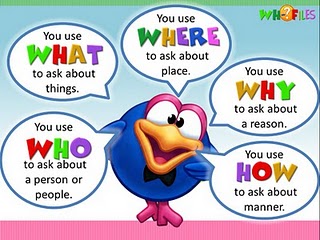
CONTENT:
These are the questions beginning with the wh-words what, who, when, where etc. and how Examples:
1. Who ate the banana?
2. What did Ojo eat?
3. When did you return?
4. How has it happened?
Wh- questions require answers other than yes or no. they require answers like:
1. It was a boy in our class.
2. He ate rice.
3. I returned yesterday.
4. It happened by chance.
Formation of wh- question
The wh- item usually has to come first in the wh-question, and then the auxiliary in the statement is used in the question. But when there is no auxiliary at all in the statement, an appropriate form of DO (do, does, or did) is used in question. Examples:
A-They have called for some reasons.
Q-Why did they call?
A-They meet somebody.
Q-Who did they meet?
However, note that when the verb in the statement is verb TO BE (am, are, is, was and were) there is no need for the auxiliary DO
A- He somewhere at the moment.
Q-Where is he at the moment?
A-They are in my bag.
Q-Where are your books?
EVALUATION:
1. Give five wh- questions
2. Form wh- questions for these statements.
i. She is here.
ii. I was doing my assignment.
iii. My name is Rose Johnson.
Further Studies
Practice Test
Practice Test
LESSON 25
ASPECT: COMPOSITION
TOPIC: Features and Outline of an Informal Letter
CONTENT:
Informal letters also known as private letters are letters written to your close friends, classmates and relations who are younger than you or about your age.

Features of an Informal Letter
• The writer’s address and date
• The salutation(opening greeting)E.g. My dear Mike, Dear Jenifer
• The opening paragraph(concerned with greetings and pleasantries)
• The main body of the letter
• The concluding paragraph
• The subscript or complimentary close. e.g. Yours ever, Yours affectionately, Yours sincerely.

Note the following with respect to the language of the informal letter
• The use of shortened form e.g. it’s, you’d, shouldn’t etc.
• The use of slangs
• The use of proverbs and jokes
• A general relaxed and pleasurable atmosphere created by the use of simple, chatty language.
EVALUATION:
Write a letter to your cousin telling him about a quiz competition that will take place in your school of which you will participate in and inviting him to witness it.
Further Studies
LESSON 26
ASPECT: Literature in English
TOPIC: Figures of Speech(Alliteration and Assonance)
CONTENT:
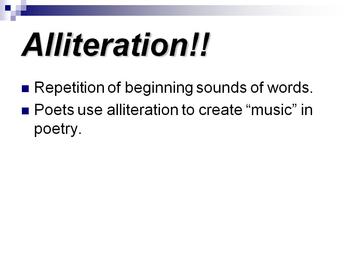
Alliteration: It is a sound device which involves the repetition of the same consonant sound in sequence. E.g.
Mummy, make indomie for me. (Repetition of /m/ sound)
Some students saw Smith stone the squirrel. (Repetition of /s/ sound)
She gave birth to a Bouncing baby boy
Dusk demand day light
Private personal preparation prevents poor public performance. (repetition of /p/)
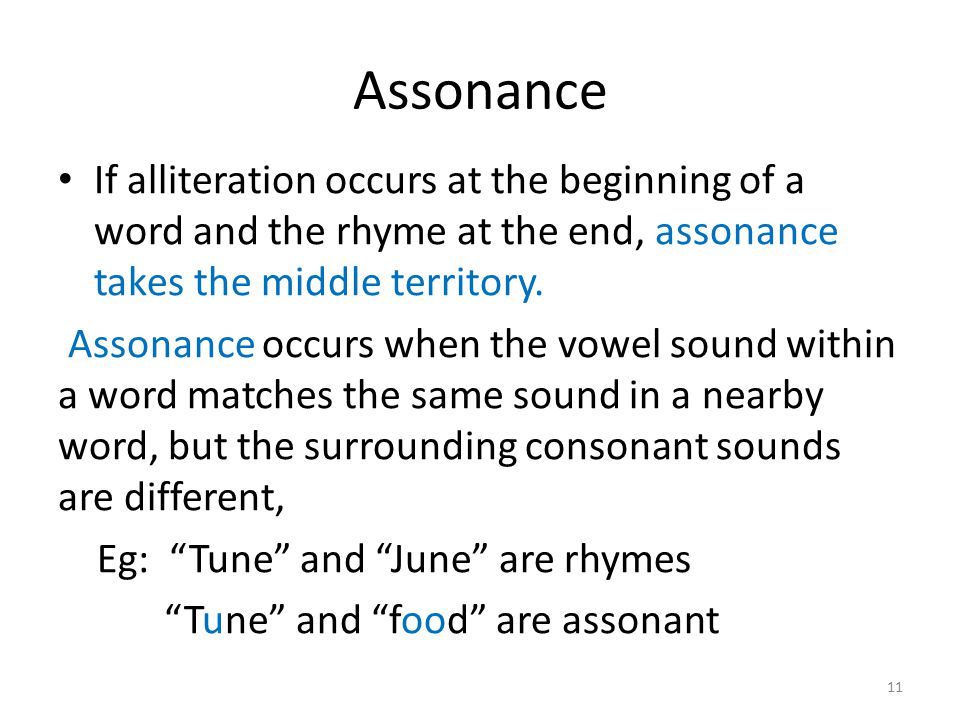
Assonance: It is a device involving the repetition of the same vowel sound in words which occur in succession e.g.
The boy wet his bed and his belt. (Repetition of /e/ sound)
Phoebe beats the tree with a key.(repetition of /i:/ sound)

EVALUATION:
1. What is alliteration and assonance?
2. Give two examples of alliteration and assonance.
ASSIGNMENT: Choose the word that contains the same sound as the sound represented by the underlined letters in the given word.
1. dogs
a. loose
b. shout
c. zeal
d. James
2. cease
a. rose
b. call
c. quick
d. student
3. those
a. cloth
b. smooth
c. wealthy
d. healthy
4. breathe
a. throw
b. them
c. width
d. mirth
5. bats
a. works
b. boys
c. debris
d. dogs
Further Studies
ASPECT: COMPREHENSION
TOPIC: Voting
When you read, evaluate carefully the opinions expressed by the writer. An opinion is a belief not based on absolute certainty or positive knowledge but on what seems true or probable to someone. In this passage, the writer’s purpose is to express opinions in order to inform and to persuade us .You are free to agree or disagree with the opinions expressed.

EVALUATION: Intensive English Book 2; Exercises 5.2.2 and 5.2.3; Page 50.
ASSIGNMENT: Intensive English Book 2; Exercises 5. 2.4, 5.2.5 and 5.3.5; pages 51-56.
LESSON 23
ASPECT: Speech Work
TOPIC: Consonant /s/, /z/, /ð/,/Ɵ/
CONTENT:
/s/, /z/ and /ð/ are consonant sounds./s/ is a voiceless alveolar fricative while /z/ is a voiced alveolar fricative.
/ð/ and /Ɵ/are called “th” sound.
/Ɵ/ is voiceless fricative while /ð/ is a voiced fricative.
Word examples of /s/, /z/ and /Ɵ//
/s/- sank, pass, salt,
/z/- breeze, sues, lays
/ð/- the, that, leather, with, breathe, father, mother, clothes,soothe, there etc.
/Ɵ/ - thank, thin, think, thought, path, breath, cloth, third, north, health, earth.
/s/
c---------s--------ss-------ps--------sw------sc
cell------sing boss psalm sword scissors
concert---fuse gossip pseudopodia science
parcel----gospel class psychology scene
There are some silent s which are not /s/ such as Island, Isle and aisle

/z/
z-------s-----ss
zebra—--present--assume
zoo-----raise----assumption
amazing-twins
azure---boys
zip-----rose
https://youtu.be/HJlpuAyZzWk
/θ /
th
think
method
anthem
bath
teeth
mathematics

https://youtu.be/X-J-rv7JXL8
/ ð /
th
then
this
those
bathe
breathe
weather
father
https://youtu.be/lenHXI85fKI
LESSON 24
ASPECT: GRAMMAR
TOPIC: The WH Question

CONTENT:
These are the questions beginning with the wh-words what, who, when, where etc. and how Examples:
1. Who ate the banana?
2. What did Ojo eat?
3. When did you return?
4. How has it happened?
Wh- questions require answers other than yes or no. they require answers like:
1. It was a boy in our class.
2. He ate rice.
3. I returned yesterday.
4. It happened by chance.
Formation of wh- question
The wh- item usually has to come first in the wh-question, and then the auxiliary in the statement is used in the question. But when there is no auxiliary at all in the statement, an appropriate form of DO (do, does, or did) is used in question. Examples:
A-They have called for some reasons.
Q-Why did they call?
A-They meet somebody.
Q-Who did they meet?
However, note that when the verb in the statement is verb TO BE (am, are, is, was and were) there is no need for the auxiliary DO
A- He somewhere at the moment.
Q-Where is he at the moment?
A-They are in my bag.
Q-Where are your books?
EVALUATION:
1. Give five wh- questions
2. Form wh- questions for these statements.
i. She is here.
ii. I was doing my assignment.
iii. My name is Rose Johnson.
Further Studies
Practice Test
Practice Test
LESSON 25
ASPECT: COMPOSITION
TOPIC: Features and Outline of an Informal Letter
CONTENT:
Informal letters also known as private letters are letters written to your close friends, classmates and relations who are younger than you or about your age.

Features of an Informal Letter
• The writer’s address and date
• The salutation(opening greeting)E.g. My dear Mike, Dear Jenifer
• The opening paragraph(concerned with greetings and pleasantries)
• The main body of the letter
• The concluding paragraph
• The subscript or complimentary close. e.g. Yours ever, Yours affectionately, Yours sincerely.

Note the following with respect to the language of the informal letter
• The use of shortened form e.g. it’s, you’d, shouldn’t etc.
• The use of slangs
• The use of proverbs and jokes
• A general relaxed and pleasurable atmosphere created by the use of simple, chatty language.
EVALUATION:
Write a letter to your cousin telling him about a quiz competition that will take place in your school of which you will participate in and inviting him to witness it.
Further Studies
LESSON 26
ASPECT: Literature in English
TOPIC: Figures of Speech(Alliteration and Assonance)
CONTENT:

Alliteration: It is a sound device which involves the repetition of the same consonant sound in sequence. E.g.
Mummy, make indomie for me. (Repetition of /m/ sound)
Some students saw Smith stone the squirrel. (Repetition of /s/ sound)
She gave birth to a Bouncing baby boy
Dusk demand day light
Private personal preparation prevents poor public performance. (repetition of /p/)

Assonance: It is a device involving the repetition of the same vowel sound in words which occur in succession e.g.
The boy wet his bed and his belt. (Repetition of /e/ sound)
Phoebe beats the tree with a key.(repetition of /i:/ sound)

EVALUATION:
1. What is alliteration and assonance?
2. Give two examples of alliteration and assonance.
ASSIGNMENT: Choose the word that contains the same sound as the sound represented by the underlined letters in the given word.
1. dogs
a. loose
b. shout
c. zeal
d. James
2. cease
a. rose
b. call
c. quick
d. student
3. those
a. cloth
b. smooth
c. wealthy
d. healthy
4. breathe
a. throw
b. them
c. width
d. mirth
5. bats
a. works
b. boys
c. debris
d. dogs
Further Studies
WEEK 7
LESSON 27
ASPECT: COMPREHENSION
TOPIC: The Campaign

In this passage ,we meet the language of political campaigns-the language of promises .The writer called it “hoarse and false promises for better working conditions, improved medical services, more and better houses”.
There are at least two forms of this political language of political manifesto which document that sets out the belief and objectives of a political party or government. The promise of housing better working conditions and so on would normally form part of party’s manifesto.
Another form of political language is political propaganda which entails spreading ideas to strengthen one’s cause while weakening the opposite side.
EVALUATION: Intensive English Book 2; Exercises 6.2.2 and 6.2.3;Page 50
ASSIGNMENT: Intensive English Book 2;Exercises 6. 2.4, 6.3.5; pages 61-71.
LESSON 28
ASPECT: Speech Work
TOPIC: Monophthong, Diphthong, Triphthong
CONTENT:
All languages have monophthongs and many languages have diphthongs, but triphthongs are relatively rare. English has all three types: the vowel sound in “hit” is a monophthong /ɪ/, the vowel sound in “boy” is a diphthong /ɔɪ/, and the vowel sounds of “flower”, /aʊə(r)/, is a triphthong.
MONOPHTHONG: It is a vowel sound whose quality doesn't change over the duration of the vowel . Monophthongs are sometimes called "pure" or "stable" vowels. E.g. /e/, /u:/, /I/,/ə/, /æ/, /ↄ:/
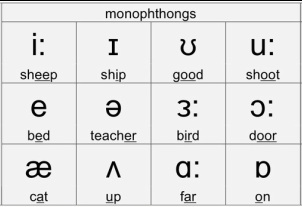

DIPHTHONG: It is a vowel sound that glides from one quality to another. It is also referred to as two quality sound. There are eight of them in British English /ei/, /ai/, /ↄi/, /eə/, /ʊә/, /aʊ /, /iә/, /әʊ/

DIPHTHONGS
/ei/
ai-----a----ea----ei—eigh---ay
pain flame great veil eight say
wait change break neigh freight lay
fail base weight may
https://youtu.be/oTAzk9xm5i8
/ai/
i----ie---eig---igh---ig---y
I----tie height high sign dry
Kite die tight cry
Mile pie fight try
Ice------------pry
wise
write
ye--uy—-ey—-hy---is
dye buy eye why aisle
bye
https://youtu.be/ub9ONgsThKc
/ↄi/
oi----oy---ouy
voice boy buoy
noise toy
point joy
boil annoy
coil
https://youtu.be/M-8ZqxVJMf8
/eә /
ar------eir--ere---ear—--air---are
scarce—their-there-swear-pair--dare
heir---------where-pear—-chair-fare
were---------------bear—hair---care
https://youtu.be/Ff-MqM6Zb4Q
/iә /
ea---ee---ier----eir
year beer fierce weird
idea steer pierce
ere—--ear---eu-----eo
here--fear museum theological
cheer-clear
https://youtu.be/4C3MKggo1vc
/uә /
u---------ure—-our---oor
curious---pure pour poor
insurance sure tour
----------cure your
https://youtu.be/feseqejnkL0
/ әu/
o----oa---ew---ow---oe—-ou----oo
go---boat-sew blow--hoe soul brooch
note goat-pew-sow--foe though
rode road-----slow-toe
https://youtu.be/Z-pZswbP0-g
/au/
ow----ou
gown thou
down loud
cow found
----doubt
----shout
https://youtu.be/JrWuLH_AYM4
TRIPHTHONG: It is a vowel sound that glides successively through three qualities. E.g. /aiә/ as in fire,/aʊə/ as in flower

auә - hour, plougher, flower
әuә - lower, blower
eiә - layer, player
aiә - higher, flyer
This is a combination of diphthongs plus SHWA.
https://youtu.be/er9TAX1_jmQ
EVALUATION:
1. Explain the following: monophthong, diphthong, triphthong.
2. Give two examples of diphthong, triphthong, and monophthong.
LESSON 29
ASPECT: Grammar
TOPIC: Tenses (Present, Past, and Future)
CONTENT:
Tenses are the different forms of a verb that expressed time.
Present Tense: A verb in the present tense normally refers to present time.
“s” is added to the singular present tense form , while the plural present tense form does not take “s”.E.g
The singular present tense form
1. The sun shines every day.
2. Ebere brushes her teeth every morning.
3. Mr. Okon speaks English quite well.
4. He steals people’s wrist watches
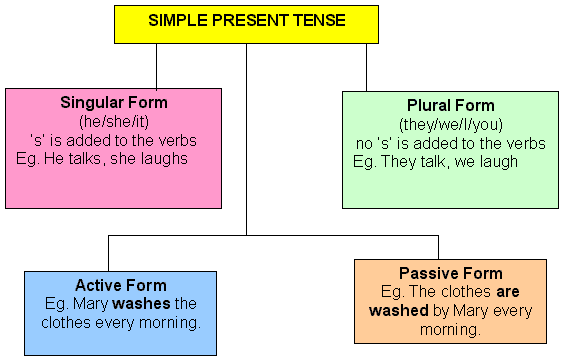
The plural present tense form
1. Spiders have eight legs.
2. Petrol and kerosene burns easily.
3. Our teachers have many books.
4. Those women cook every day.
Past tense: Verbs in the past tense are expressed by actions that have taken place at a fixed time in the past. E.g.
1. Mr. Okere visited us last week.
2. The principal was here five minutes ago.
3. I read my English note last night.
4. He kept the books on the table.

Future tense: Verbs in the future tense show actions that will take place sometime in the future. It is often expressed using the modal auxiliaries “will!” and “shall”. E.g.
1. He will leave for Enugu tomorrow.
2. She will be here in an hour’s time.
3. I shall see her Friday.

Apart from “will” and “shall”, “may” can be used to refer to future situation. E.g.
1. He may travel in the afternoon.
2. She may visit her uncle next week.
English has a few ways of expressing futurity. Some of which are:
(a) Auxiliary verb construction
(i) Shall + vb + infinite (1st person singular only )
(ii) Will + vb + infinite (all persons) e.g.
I shall try to do my best
She will be here in a moment
(iii)Future orientation in the past(will + perfect)
e.g.
She will have finished her exams by next week
(iv) Will / shall + be + vb + ing + (time) e.g.
I shall / will be doing my best in this test.
(b) Be + going to + verb
(i) Future of present intention
When is Wale going to get married.
(ii) Future of present cause
It is going to rain.
(c) Be + vb + ing + (time)
(i) Future anticipation in the present.
He is travelling tomorrow
(ii) Present continuous / progressive
I am watching that video tonight
(iii) Transition
The Governor is coming to Christ College.
(d) Be + about to + vb
Imminent fulfillment
We are about to leave.
(e) Vb + s
(i) Subordinate conditional clause
What will you do if she marries the chief?
(ii) Immutable event
When is summer?
(iii) Calendar statements
Tomorrow is Friday.
(f) Be + infinitive + vb
(i) Arrangement
They are to be married today
(ii) Command
You are to be here at 10.00am
(iii) Pre-destined future
If you are to succeed, you must work hard.
(g) Vb + s + (time)
She travels tomorrow
The robbers die by hanging
The train leaves at 10.00pm
(h) Wil + shall + vb + time
I will see you next week
She will travel on Monday
We shall meet soon
EVALUATION: Use the appropriate forms of the verbs in brackets in the in the following sentences:
1. I have not (meet) her recently.
2. Good! Yakubu (do)his homework now.
3. I (live) in London when I first met him.
4. Before the celebrations, many children(buy) new clothes.
5. It (be) the new students’ turn tomorrow.
Short Practice Test 1
Short Practice Test 2
Short Practice Test 3
LESSON 30
ASPECT: LITERATURE
TOPIC: Irony, Paradox and oxymoron
CONTENT:
Irony: The meaning contradicts the ordinary statement.
1. You must be very clever for scoring 20% in your examination.
2. Isn’t it comforting to watch one’s car being driven away by armed robbers?
3. He was so intelligent that he failed his examination.
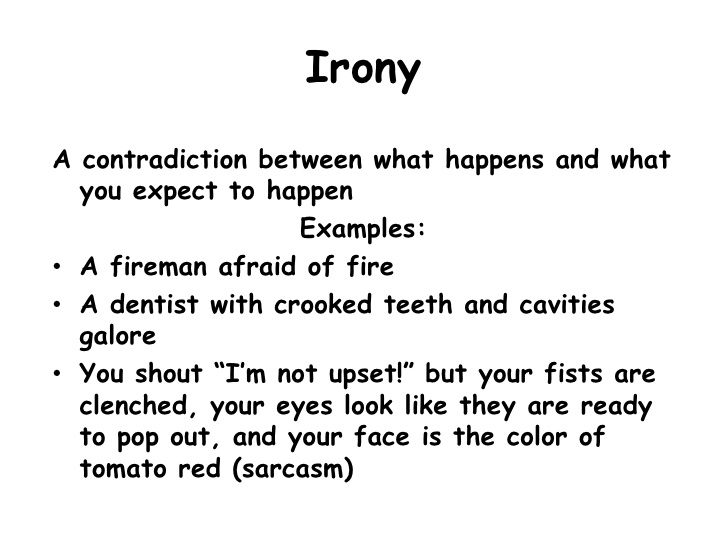
Paradox: It is an expression which is absurd or false on the surface, but in a larger context or upon reflection, it is true. E.g.
1. The child is the father of the man.
2. Nigeria’s unity lies in her diversity.
3. The more you look the less you see.
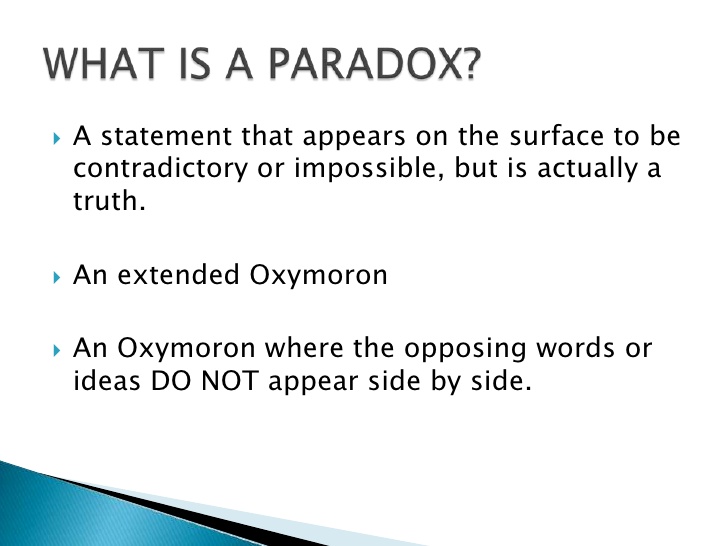
Oxymoron: Words of opposite meaning or suggestion are used together, with one serving as a qualifier for the other. It can also be defined as the side by side placement of two contrasting words. E.g.
1. A wise fool.
2. Death is a cruel kindness.
3. It was a sweet bitter experience.
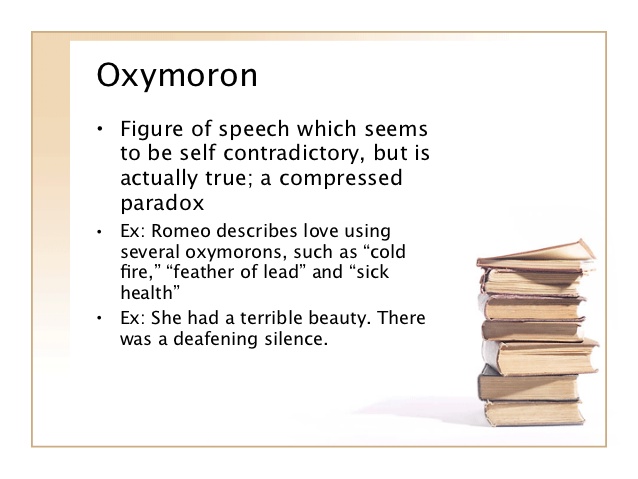
https://www.slideshare.net/aciacisejYWO ... e-43708208
ASSIGNMENT: Use the most appropriate options from the alternatives lettered A-D to fill in the gaps in the following sentences.
1. Nowadays, Nduka _________ a novel every week A. read b. has read c. have read d. reads
2. We have already _________ the carpet on the floor a. lain b. lay c. laid d. laying
3. He ________ at the university before he got married a. has finished b. have finished c. had finished d. was finished
4. The poor old woman ______ her pepper on the stone for twenty years a. has ground b. had grinded c. has grind d. has grounded
5. Mummy was cooking when daddy ________ a. has returned b. returned c. had returned d. returns
ASPECT: COMPREHENSION
TOPIC: The Campaign

In this passage ,we meet the language of political campaigns-the language of promises .The writer called it “hoarse and false promises for better working conditions, improved medical services, more and better houses”.
There are at least two forms of this political language of political manifesto which document that sets out the belief and objectives of a political party or government. The promise of housing better working conditions and so on would normally form part of party’s manifesto.
Another form of political language is political propaganda which entails spreading ideas to strengthen one’s cause while weakening the opposite side.
EVALUATION: Intensive English Book 2; Exercises 6.2.2 and 6.2.3;Page 50
ASSIGNMENT: Intensive English Book 2;Exercises 6. 2.4, 6.3.5; pages 61-71.
LESSON 28
ASPECT: Speech Work
TOPIC: Monophthong, Diphthong, Triphthong
CONTENT:
All languages have monophthongs and many languages have diphthongs, but triphthongs are relatively rare. English has all three types: the vowel sound in “hit” is a monophthong /ɪ/, the vowel sound in “boy” is a diphthong /ɔɪ/, and the vowel sounds of “flower”, /aʊə(r)/, is a triphthong.
MONOPHTHONG: It is a vowel sound whose quality doesn't change over the duration of the vowel . Monophthongs are sometimes called "pure" or "stable" vowels. E.g. /e/, /u:/, /I/,/ə/, /æ/, /ↄ:/


DIPHTHONG: It is a vowel sound that glides from one quality to another. It is also referred to as two quality sound. There are eight of them in British English /ei/, /ai/, /ↄi/, /eə/, /ʊә/, /aʊ /, /iә/, /әʊ/

DIPHTHONGS
/ei/
ai-----a----ea----ei—eigh---ay
pain flame great veil eight say
wait change break neigh freight lay
fail base weight may
https://youtu.be/oTAzk9xm5i8
/ai/
i----ie---eig---igh---ig---y
I----tie height high sign dry
Kite die tight cry
Mile pie fight try
Ice------------pry
wise
write
ye--uy—-ey—-hy---is
dye buy eye why aisle
bye
https://youtu.be/ub9ONgsThKc
/ↄi/
oi----oy---ouy
voice boy buoy
noise toy
point joy
boil annoy
coil
https://youtu.be/M-8ZqxVJMf8
/eә /
ar------eir--ere---ear—--air---are
scarce—their-there-swear-pair--dare
heir---------where-pear—-chair-fare
were---------------bear—hair---care
https://youtu.be/Ff-MqM6Zb4Q
/iә /
ea---ee---ier----eir
year beer fierce weird
idea steer pierce
ere—--ear---eu-----eo
here--fear museum theological
cheer-clear
https://youtu.be/4C3MKggo1vc
/uә /
u---------ure—-our---oor
curious---pure pour poor
insurance sure tour
----------cure your
https://youtu.be/feseqejnkL0
/ әu/
o----oa---ew---ow---oe—-ou----oo
go---boat-sew blow--hoe soul brooch
note goat-pew-sow--foe though
rode road-----slow-toe
https://youtu.be/Z-pZswbP0-g
/au/
ow----ou
gown thou
down loud
cow found
----doubt
----shout
https://youtu.be/JrWuLH_AYM4
TRIPHTHONG: It is a vowel sound that glides successively through three qualities. E.g. /aiә/ as in fire,/aʊə/ as in flower

auә - hour, plougher, flower
әuә - lower, blower
eiә - layer, player
aiә - higher, flyer
This is a combination of diphthongs plus SHWA.
https://youtu.be/er9TAX1_jmQ
EVALUATION:
1. Explain the following: monophthong, diphthong, triphthong.
2. Give two examples of diphthong, triphthong, and monophthong.
LESSON 29
ASPECT: Grammar
TOPIC: Tenses (Present, Past, and Future)
CONTENT:
Tenses are the different forms of a verb that expressed time.
Present Tense: A verb in the present tense normally refers to present time.
“s” is added to the singular present tense form , while the plural present tense form does not take “s”.E.g
The singular present tense form
1. The sun shines every day.
2. Ebere brushes her teeth every morning.
3. Mr. Okon speaks English quite well.
4. He steals people’s wrist watches

The plural present tense form
1. Spiders have eight legs.
2. Petrol and kerosene burns easily.
3. Our teachers have many books.
4. Those women cook every day.
Past tense: Verbs in the past tense are expressed by actions that have taken place at a fixed time in the past. E.g.
1. Mr. Okere visited us last week.
2. The principal was here five minutes ago.
3. I read my English note last night.
4. He kept the books on the table.

Future tense: Verbs in the future tense show actions that will take place sometime in the future. It is often expressed using the modal auxiliaries “will!” and “shall”. E.g.
1. He will leave for Enugu tomorrow.
2. She will be here in an hour’s time.
3. I shall see her Friday.

Apart from “will” and “shall”, “may” can be used to refer to future situation. E.g.
1. He may travel in the afternoon.
2. She may visit her uncle next week.
English has a few ways of expressing futurity. Some of which are:
(a) Auxiliary verb construction
(i) Shall + vb + infinite (1st person singular only )
(ii) Will + vb + infinite (all persons) e.g.
I shall try to do my best
She will be here in a moment
(iii)Future orientation in the past(will + perfect)
e.g.
She will have finished her exams by next week
(iv) Will / shall + be + vb + ing + (time) e.g.
I shall / will be doing my best in this test.
(b) Be + going to + verb
(i) Future of present intention
When is Wale going to get married.
(ii) Future of present cause
It is going to rain.
(c) Be + vb + ing + (time)
(i) Future anticipation in the present.
He is travelling tomorrow
(ii) Present continuous / progressive
I am watching that video tonight
(iii) Transition
The Governor is coming to Christ College.
(d) Be + about to + vb
Imminent fulfillment
We are about to leave.
(e) Vb + s
(i) Subordinate conditional clause
What will you do if she marries the chief?
(ii) Immutable event
When is summer?
(iii) Calendar statements
Tomorrow is Friday.
(f) Be + infinitive + vb
(i) Arrangement
They are to be married today
(ii) Command
You are to be here at 10.00am
(iii) Pre-destined future
If you are to succeed, you must work hard.
(g) Vb + s + (time)
She travels tomorrow
The robbers die by hanging
The train leaves at 10.00pm
(h) Wil + shall + vb + time
I will see you next week
She will travel on Monday
We shall meet soon
EVALUATION: Use the appropriate forms of the verbs in brackets in the in the following sentences:
1. I have not (meet) her recently.
2. Good! Yakubu (do)his homework now.
3. I (live) in London when I first met him.
4. Before the celebrations, many children(buy) new clothes.
5. It (be) the new students’ turn tomorrow.
Short Practice Test 1
Short Practice Test 2
Short Practice Test 3
LESSON 30
ASPECT: LITERATURE
TOPIC: Irony, Paradox and oxymoron
CONTENT:
Irony: The meaning contradicts the ordinary statement.
1. You must be very clever for scoring 20% in your examination.
2. Isn’t it comforting to watch one’s car being driven away by armed robbers?
3. He was so intelligent that he failed his examination.

Paradox: It is an expression which is absurd or false on the surface, but in a larger context or upon reflection, it is true. E.g.
1. The child is the father of the man.
2. Nigeria’s unity lies in her diversity.
3. The more you look the less you see.

Oxymoron: Words of opposite meaning or suggestion are used together, with one serving as a qualifier for the other. It can also be defined as the side by side placement of two contrasting words. E.g.
1. A wise fool.
2. Death is a cruel kindness.
3. It was a sweet bitter experience.

https://www.slideshare.net/aciacisejYWO ... e-43708208
ASSIGNMENT: Use the most appropriate options from the alternatives lettered A-D to fill in the gaps in the following sentences.
1. Nowadays, Nduka _________ a novel every week A. read b. has read c. have read d. reads
2. We have already _________ the carpet on the floor a. lain b. lay c. laid d. laying
3. He ________ at the university before he got married a. has finished b. have finished c. had finished d. was finished
4. The poor old woman ______ her pepper on the stone for twenty years a. has ground b. had grinded c. has grind d. has grounded
5. Mummy was cooking when daddy ________ a. has returned b. returned c. had returned d. returns
WEEK 8
LESSON 31
ASPECT: COMPREHENSION
TOPIC: SWEET AND LOW

Poetry expresses the feeling of the writer through a number or devices .Expressive word appeals to the senses of touch, taste, sight, and hearing.
The tune or beating rhythm makes the poem colourful.
Other poetic devices.
• Rhyme--where words at the end of lines sound alike.
• Alliteration –where the consonant sound at the beginning of a word is repeated in the line of poetry.
• Repetition of words and phrases for effect.
• Use of figures of speech like similes metaphors and personification.
• It is a song -like- poem a lullaby, it is an example of lyric poetry.
Read the passage below carefully and answer the questions that follow.
EVALUATION: Intensive English Book 2; Exercise 7.2.2; Page75
ASSIGNMENT: Intensive English Book 2 Exercises 7. 2.3, &7.3.5; pages 75-81.
Further Studies 1
Further Studies 2
LESSON 32
ASPECT: Speech Work
TOPIC: Morpheme -Word boundaries-prefix
Content:
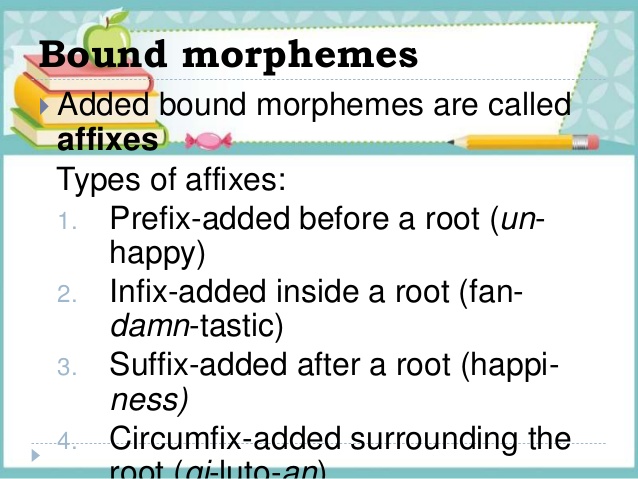
Affixes are small word bits. They are added to the base forms of particular words. There are two main kinds in English: prefixes and suffixes.
Prefixes: prefixes are affixes added to the beginning of the base forms. e.g. un , dis, im, non, il, in, mis, mal, over, sub, sur, out, inter, trans, pre, pro, post. Ex, re,
E.g.
Un-(not) e.g. unhappy, unkind, unreasonable, ungrateful, unwise etc.
Non - e.g. non-alcoholic, non-violent, non-verbal, non-standard etc.
Dis e.g. disloyal, disagree, disapproval, disorder, disobey, disrespectful etc.
Il- e.g. illogical, illegal, illiteracy …
Mis- e.g. miscalculate, misunderstand, misrepresent …
Mal- (bad) e.g. maltreat, maltreatment, malpractice…
Sur- (extra) e.g. surcharge, surtax
Sub- (lower than) e.g. substandard, subhuman, subcommittee
Counter (against) e.g. counterattack,
Re- e.g. repay, resettlement, reuse, reconstruct etc.
Ex- (former) e.g. ex-husband, ex-president, ex-student, etc.

https://youtu.be/1ffjfpMl9-4
EVALUATION:
Form two words with these prefixes.
Pre, ex, sub, super, non, over, out
Further Studies 1
Further Studies 1
LESSON 33 & 34
ASPECT: Grammar
TOPIC: Preposition and Prepositional Phrase
Content:
Prepositions are words that show relationship between a noun or pronoun and other words a sentence. E.g. in ,on, beside, in front of , under, above, outside, to, over, by, beyond etc.
The river flows into the sea.
She apologized for her wrong doing.
The suspects were arraigned before the court.
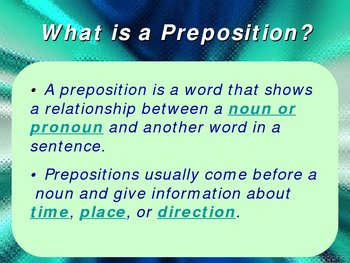
USE OF PREPOSITION:
Prepositions look very simple but difficult to determine or understand when it comes to making choices of
them. Prepositions are defined as words that help to show the relationship between Nouns or Pronouns in a sentence. e.g.
1. The book is on the desk
2. The book is under the desk
3. The book is inside the desk
4. The book is beside the desk
5. The book is above the desk
The words in red above look so simple but they effected a change in the meaning of each of the sentences in which they appear. Preposition can be classified functionally as follows:
(a) To indicate position or place
1. He is at home
2. The plane is in the sky
3. The boat is above the water
(b) To show direction or movement
1. They are travelling to America
2. We are moving from our house
3. He is running after the cat
4. She is going toward the hostel
(c) To indicate location
1. He lives in Lagos (if you know where he stays there)
2. He lives at Aguda (if you don’t know where exactly)
3. He lectures at the University of Lagos. (General)
4. He lectures in the Faculty of Art (more specific)
(d) To express the purpose for an action
1. I am saving towards an investment
2. You should listen for the sake of your children
(e) To indicate the manner or style of doing something
1. The book is fashioned after Achebe
2. He spoke with anger
3. She destroyed the goods in annoyance
(f) To give an idea of time / duration
1. The meeting did not hold for three days
2. They will not come till next week
(g) To indicate extent of space or distance
1. He travelled for two days and night
2. They are putting 12,000 kilometres of road under construction
(h) To indicate antagonism or opposition
1. Ali fought with Bassey
2. Hogan contested against the warriors
(i) To indicate ownership or origin
1. I am the son of Elijah
2. This book is written by Sola Agunbiade
(j) To indicate “IN SPITE OF”
1. He did not win the contract after all his effort
2. I love you with all your weakness
3. I still like the game for the dangers involved
(k) To express goodwill
1. I congratulate you on your new appointment
2. I commend you for your patience
3. I want you to be at your best tomorrow
These are few of the functions of prepositions and you will notice that some prepositions perform more than three or more of these functions. The choice of one over another is a matter of appropriateness in the context in which they are used.
Prepositions can be used in this manner.
According to, afflicted with, agree to(something), agree with(somebody), aim at, angry at(something), angry with(somebody), apply for(something) apply to(somebody), change for(something), change with(somebody), disgusted at(something),disgusted with(somebody), die of, differ from(opinion), complain of, divide among(many), divide between(two), conscious of, filled with, full of, inferior to(something), part from(somebody), part with(something), prevail on, tired of(something) tired with(action), meddle with, dislike for, suffer from etc.
Prepositional phrase: A preposition with the noun, noun phrase or pronoun following it is known as prepositional phrase. Better still, a Prepositional Phrase is a group of words headed by a preposition (and usually followed by a noun, pronoun or nominal group).
She campaigned for him
He went there with her.
Put the book on the shelf.
He lost to some extent.
Some people will come in the evening.
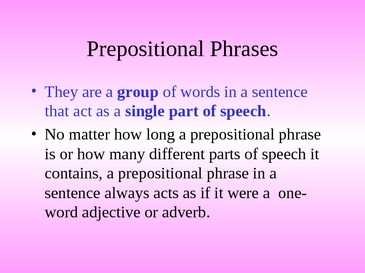
Prepositional phrases with special meanings
Prepositional phrase often has meanings that are not clear. Such grammatical phrases are actually idiomatic expressions. Some examples are:
1. above board (completely honest and open)
His handling of the company was above board.
2. across the board (affecting all groups,members)
There was a 100% increase in salaries across the board
3. beyond once widest dream.(better than one imagined or hoped for)
Receiving the price for mathematics was beyond my wildest dreams
4. off the cuff(spontaneously, without being planned or practiced in advance)
He made the remarks off the cuff.
It was an off-the- cuff remark.
5. through thick and thin(in all conditions, good or bad)
They remained friends through thick and thin.
EVALUATION: Identify the prepositional phrases in these sentences.
1. They were not very happy with him.
2. Those who live in Abuja saw her.
3. The police ordered the tugs out of the building.
4. Every student in uniform was given a flag.
5. She did not come on account of you.
ASSIGNMENT: Complete each of the following questions with the most appropriate of the options lettered A-D.
1. Students should not discriminate ______ one another a. against b. at c. between d. from
2. I was worried _________ his lateness a. at b. over c. for d. about
3. Mr.Uche was always pleased __________ his wife a. about b. by c. with d. for
4. He lent his bicycle ________ a boy he hardly knew a. for b. from c. to d. with
5. Only a fool would prefer a car ______ a wife a. above b. for c. than d. over
Further Studies 1
Further Studies 2
Short Practice Test 1
Short Practice Test 3
ASPECT: COMPREHENSION
TOPIC: SWEET AND LOW

Poetry expresses the feeling of the writer through a number or devices .Expressive word appeals to the senses of touch, taste, sight, and hearing.
The tune or beating rhythm makes the poem colourful.
Other poetic devices.
• Rhyme--where words at the end of lines sound alike.
• Alliteration –where the consonant sound at the beginning of a word is repeated in the line of poetry.
• Repetition of words and phrases for effect.
• Use of figures of speech like similes metaphors and personification.
• It is a song -like- poem a lullaby, it is an example of lyric poetry.
Read the passage below carefully and answer the questions that follow.
EVALUATION: Intensive English Book 2; Exercise 7.2.2; Page75
ASSIGNMENT: Intensive English Book 2 Exercises 7. 2.3, &7.3.5; pages 75-81.
Further Studies 1
Further Studies 2
LESSON 32
ASPECT: Speech Work
TOPIC: Morpheme -Word boundaries-prefix
Content:

Affixes are small word bits. They are added to the base forms of particular words. There are two main kinds in English: prefixes and suffixes.
Prefixes: prefixes are affixes added to the beginning of the base forms. e.g. un , dis, im, non, il, in, mis, mal, over, sub, sur, out, inter, trans, pre, pro, post. Ex, re,
E.g.
Un-(not) e.g. unhappy, unkind, unreasonable, ungrateful, unwise etc.
Non - e.g. non-alcoholic, non-violent, non-verbal, non-standard etc.
Dis e.g. disloyal, disagree, disapproval, disorder, disobey, disrespectful etc.
Il- e.g. illogical, illegal, illiteracy …
Mis- e.g. miscalculate, misunderstand, misrepresent …
Mal- (bad) e.g. maltreat, maltreatment, malpractice…
Sur- (extra) e.g. surcharge, surtax
Sub- (lower than) e.g. substandard, subhuman, subcommittee
Counter (against) e.g. counterattack,
Re- e.g. repay, resettlement, reuse, reconstruct etc.
Ex- (former) e.g. ex-husband, ex-president, ex-student, etc.

https://youtu.be/1ffjfpMl9-4
EVALUATION:
Form two words with these prefixes.
Pre, ex, sub, super, non, over, out
Further Studies 1
Further Studies 1
LESSON 33 & 34
ASPECT: Grammar
TOPIC: Preposition and Prepositional Phrase
Content:
Prepositions are words that show relationship between a noun or pronoun and other words a sentence. E.g. in ,on, beside, in front of , under, above, outside, to, over, by, beyond etc.
The river flows into the sea.
She apologized for her wrong doing.
The suspects were arraigned before the court.

USE OF PREPOSITION:
Prepositions look very simple but difficult to determine or understand when it comes to making choices of
them. Prepositions are defined as words that help to show the relationship between Nouns or Pronouns in a sentence. e.g.
1. The book is on the desk
2. The book is under the desk
3. The book is inside the desk
4. The book is beside the desk
5. The book is above the desk
The words in red above look so simple but they effected a change in the meaning of each of the sentences in which they appear. Preposition can be classified functionally as follows:
(a) To indicate position or place
1. He is at home
2. The plane is in the sky
3. The boat is above the water
(b) To show direction or movement
1. They are travelling to America
2. We are moving from our house
3. He is running after the cat
4. She is going toward the hostel
(c) To indicate location
1. He lives in Lagos (if you know where he stays there)
2. He lives at Aguda (if you don’t know where exactly)
3. He lectures at the University of Lagos. (General)
4. He lectures in the Faculty of Art (more specific)
(d) To express the purpose for an action
1. I am saving towards an investment
2. You should listen for the sake of your children
(e) To indicate the manner or style of doing something
1. The book is fashioned after Achebe
2. He spoke with anger
3. She destroyed the goods in annoyance
(f) To give an idea of time / duration
1. The meeting did not hold for three days
2. They will not come till next week
(g) To indicate extent of space or distance
1. He travelled for two days and night
2. They are putting 12,000 kilometres of road under construction
(h) To indicate antagonism or opposition
1. Ali fought with Bassey
2. Hogan contested against the warriors
(i) To indicate ownership or origin
1. I am the son of Elijah
2. This book is written by Sola Agunbiade
(j) To indicate “IN SPITE OF”
1. He did not win the contract after all his effort
2. I love you with all your weakness
3. I still like the game for the dangers involved
(k) To express goodwill
1. I congratulate you on your new appointment
2. I commend you for your patience
3. I want you to be at your best tomorrow
These are few of the functions of prepositions and you will notice that some prepositions perform more than three or more of these functions. The choice of one over another is a matter of appropriateness in the context in which they are used.
Prepositions can be used in this manner.
According to, afflicted with, agree to(something), agree with(somebody), aim at, angry at(something), angry with(somebody), apply for(something) apply to(somebody), change for(something), change with(somebody), disgusted at(something),disgusted with(somebody), die of, differ from(opinion), complain of, divide among(many), divide between(two), conscious of, filled with, full of, inferior to(something), part from(somebody), part with(something), prevail on, tired of(something) tired with(action), meddle with, dislike for, suffer from etc.
Prepositional phrase: A preposition with the noun, noun phrase or pronoun following it is known as prepositional phrase. Better still, a Prepositional Phrase is a group of words headed by a preposition (and usually followed by a noun, pronoun or nominal group).
She campaigned for him
He went there with her.
Put the book on the shelf.
He lost to some extent.
Some people will come in the evening.

Prepositional phrases with special meanings
Prepositional phrase often has meanings that are not clear. Such grammatical phrases are actually idiomatic expressions. Some examples are:
1. above board (completely honest and open)
His handling of the company was above board.
2. across the board (affecting all groups,members)
There was a 100% increase in salaries across the board
3. beyond once widest dream.(better than one imagined or hoped for)
Receiving the price for mathematics was beyond my wildest dreams
4. off the cuff(spontaneously, without being planned or practiced in advance)
He made the remarks off the cuff.
It was an off-the- cuff remark.
5. through thick and thin(in all conditions, good or bad)
They remained friends through thick and thin.
EVALUATION: Identify the prepositional phrases in these sentences.
1. They were not very happy with him.
2. Those who live in Abuja saw her.
3. The police ordered the tugs out of the building.
4. Every student in uniform was given a flag.
5. She did not come on account of you.
ASSIGNMENT: Complete each of the following questions with the most appropriate of the options lettered A-D.
1. Students should not discriminate ______ one another a. against b. at c. between d. from
2. I was worried _________ his lateness a. at b. over c. for d. about
3. Mr.Uche was always pleased __________ his wife a. about b. by c. with d. for
4. He lent his bicycle ________ a boy he hardly knew a. for b. from c. to d. with
5. Only a fool would prefer a car ______ a wife a. above b. for c. than d. over
Further Studies 1
Further Studies 2
Short Practice Test 1
Short Practice Test 3
WEEK 9
LESSON 36
ASPECT: COMPREHENSION
TOPIC: In the Legislature

One device that writers use to help readers follow their arguments is that linking words or phrases. These linking words tell the order in which things are done. E.g.
The committee has four main courses of action
The first is………………………………………………………………
Secondly………………………………………………………………….
Thirdly…………………………………………………………………….
Fourthly/Lastly…………………………………………………………………..
Organize your own writing by using linking word appropriately.
EVALUATION: Intensive English Book 2 Exercises 8.2.2 & 8.2.3 Page 87.
ASSIGNMENT: Intensive English Book 2 Exercise: 8. 2.4 & 8.3.5;pages 87- 95.
LESSON 37
ASPECT: Speech Work
TOPIC: Suffix
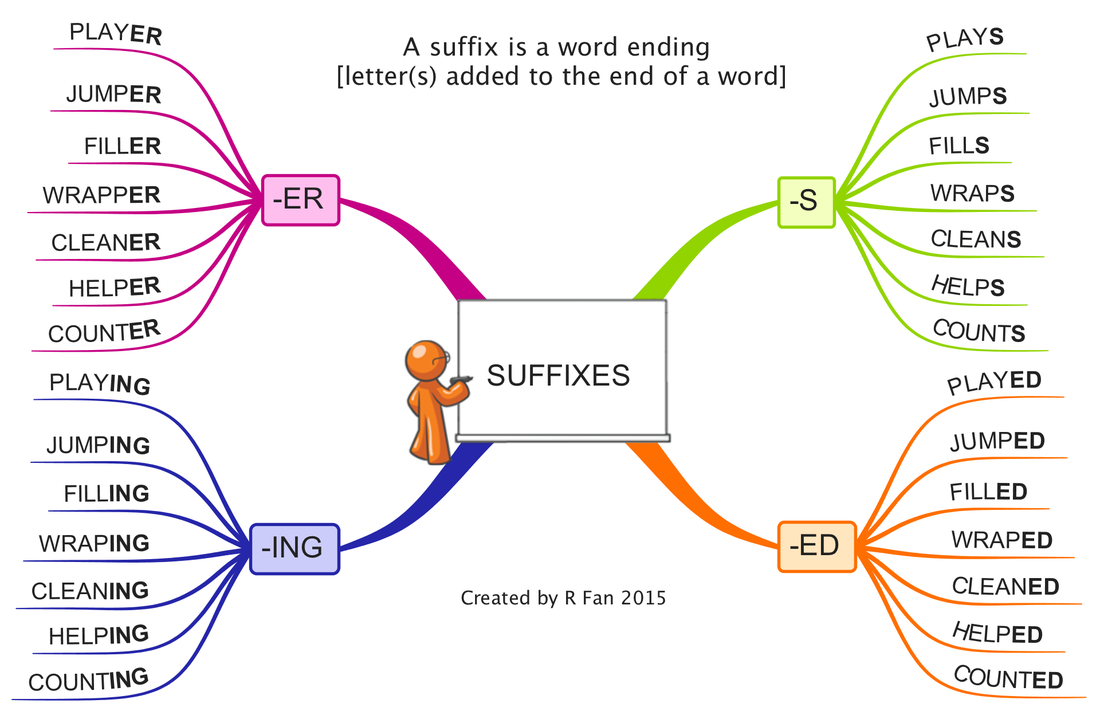
Content:
Suffixes are the affixes added after the base forms. It can be used to form noun, verb, adjective, adverbs. It may more than one meaning. e.g. ness, ify, ize, en, ful, al, tion, er, ship, ant, hood, less, ish, wise etc.
Use of suffixes to form Nouns
adjective+ness happiness (the state of been happy),
wickedness, foolishness,sickness, awareness, etc.
Use of suffixes to form verb
Noun/adjective+ify beautify (cause to be beautiful), simplify,electrify
Ize synthesize,terrorize, sympathize, practicalize
Adjective+en darken (become dark), sharpen, quicken, widen
Use of suffixes to form adjective
Noun+ful delightful,hopeful, mouthful, fruitful
Noun+al practical, presidential, theoretical, instrumental…
Verb+ment achievement, establishment, punishment…
Verb+er/or/-r singer, amplifier, conductor, narrator, receiver…
Verb+ation/tion education, introduction, interpretation…
Noun+less noiseless, childless, harmless,careless…
Adjective+ish smallish, greenish, darkish,grayish…
Use of suffixes to form adverbs
Adjective+ly - beautifully, attentively, independently, quickly…
Noun/adverb+ward(s) - homewards, northwards, downwards, coastwards…
Noun+wise - clockwise, technology-wise, business-wise, education-wise...
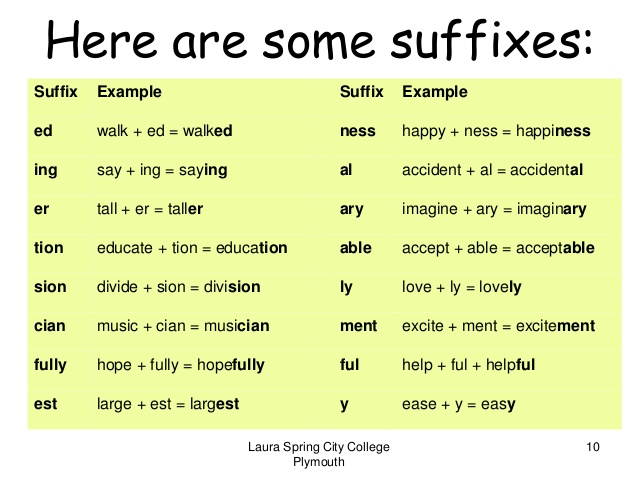
Evaluation: Write the noun form of these adjectives:
noiseless, careless, delightful, fruitful, practical, instrumental, wicked, happy, aware.
Further Studies 1
Further Studies 2
Short Practice Test 1
Short Practice Test 2
Short Practice Test 3
LESSON 38
ASPECT: Grammar
TOPIC: Conjunction(Types and Usage)

Content:
Conjunctions are words used for joining other words, or groups of words, in sentences. There are three types of conjunctions;
1. Coordinating conjunctions
2. Correlative conjunctions
3. Subordinating conjunctions
Coordinating conjunctions:
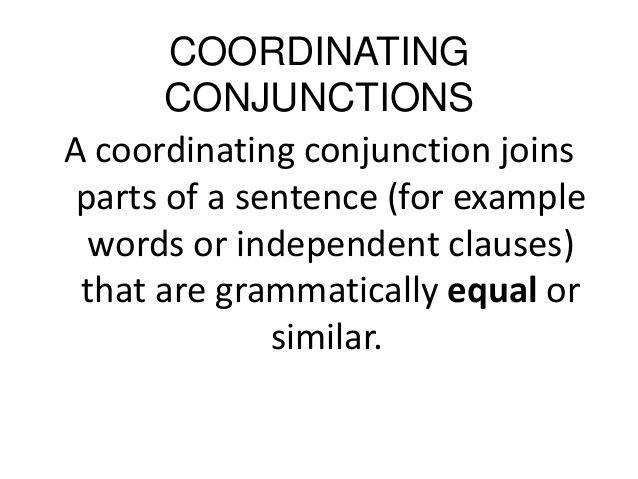
They are also known as coordinators. They are but, or, and. examples
Boys and girls sometimes think differently.
The little girl sang and danced.
He promised to bring it, but he never did.
You may come yourself, or you may send someone.
Correlative conjunction:

These are conjunctions that are used in pairs. E.g both…and, either…or, neither…nor, not only…but also.
1. Both Mary and Ngozi are his cousins.
2. Either Tony or Bolu will be chosen.
3. She neither came nor send someone else.
4. Not only did she insult him but also slapped him.
Subordinating conjunctions:

They are also known as subordinators. Examples are when, where, while, although, because, if, until, till, that, unless etc.
1. I shall see you when I come back.
2. The teacher explained why the sun always rises from the east.
3. Unless you work hard, you may not pass.
4. While she was working, the child sneaked out.

Evaluation: Underline the conjunction used in the following sentences and identify the type of conjunction used in each case.
1. Come if you please.
2. We saw a man, woman and a little girl.
3. He not only wrote but also sent some money.
4. Both Bimbo and Sola look alike.
5. You can see me when you are leaving.
Further Studies 1
Further Studies 2
Practice Test 1
Practice Test 2
LESSON 39
ASPECT: Composition
TOPIC: Stating the Differences between Formal and Informal Letter.
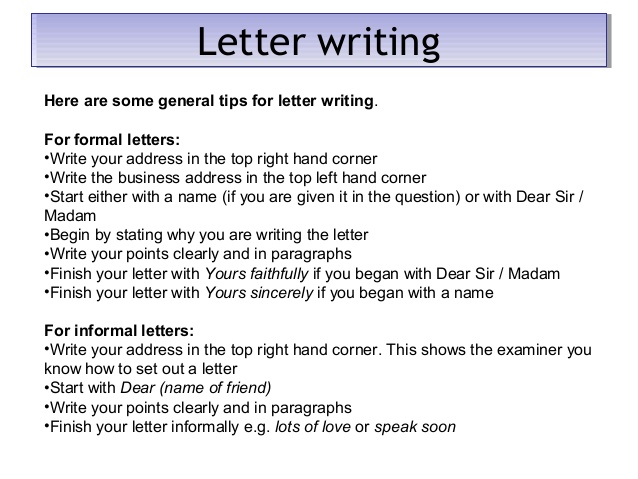
Content:
Differences between Formal and Informal Letter
Formal letter VS Informal letter
Two addresses(address of the writer and addressee)............ One address (writer’s address)
Salutation(Dear Sir/Madam)........... Salutation(Dear Tony, My dear sister)
Topic or subject heading ............No topic
Strict and polite language ............ Loose language.
No shortened form ...............Use of shortened forms like I’m, it’s.
No slangs................ Use of slangs and jokes.
Complimentary close (Yours faithfully) ..............Complimentary close (Yours sincerely, Yours ever, Yours affectionately)
Signature and Full name ..............No signature, only first name is written
EVALUATION: State the differences between formal letter and informal letter.
Further Studies
LESSON 40
ASPECT: Literature
TOPIC: Apostrophe, Euphemism, Metonymy
Content:
Apostrophe:
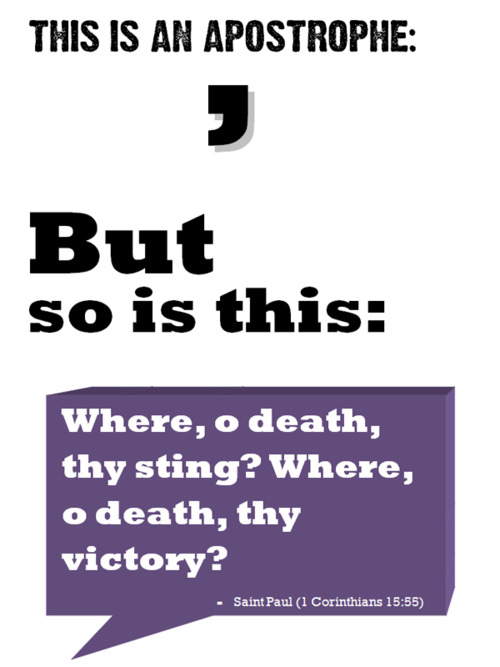
It is essentially an address to an absent person, a dead person or a non-living thing, e.g.
“Africa”
“Africa my Africa,
Africa of proud warriors in the ancestral savannahs”
Lines 1 and 2
Further Studies
Euphemism:
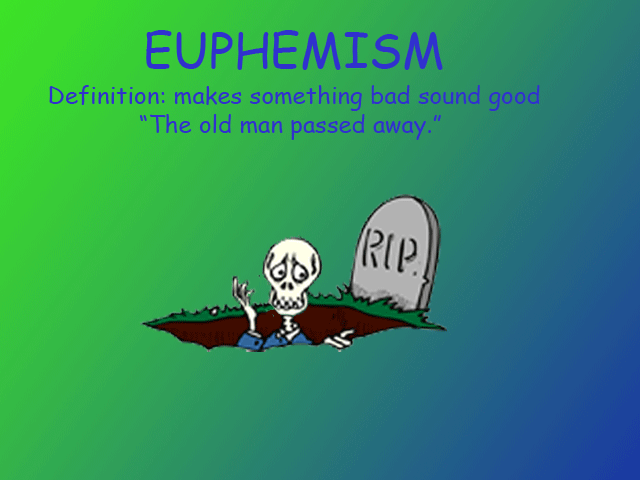
It is the presentation of an unpleasant thing or experience in a pleasant way. e.g.
1. The king has joined his ancestors.
2. The girl has been put in family way.
3. The madman’s sores have a gentle odour.
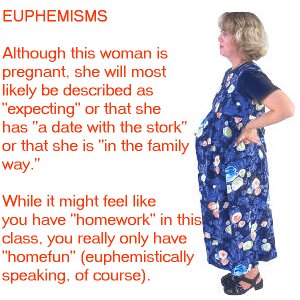
Further Studies 1
Further Studies 2
Metonymy:

The use of one thing to stand for another thing with which it has a direct relationship. E.g.
The pen is mightier than the sword.(pen represents journalism, sword represents the soldier)
Further Studies 1
Further Studies 2
ASSIGNMENT: From the alternatives lettered A-D, choose the best option for the gap in each of the following sentences
a. That kind of excursion is ________ possible at this time of the year a. in b. il c. un d. im
b. None of the following can take the prefix dis-EXPECT _____ A. soft b. make c. act d. able
c. In the word anti- robbery, the prefix anti- means ________ a. between b. across c. against d. for
d. All the following can take the suffix –hood EXCEPT_________ A. adulthood b. brother c. boy d. sing
e. In the word mal-treatment the prefix mal- means ________ a. better b. extra c. for d. bad
ASPECT: COMPREHENSION
TOPIC: In the Legislature

One device that writers use to help readers follow their arguments is that linking words or phrases. These linking words tell the order in which things are done. E.g.
The committee has four main courses of action
The first is………………………………………………………………
Secondly………………………………………………………………….
Thirdly…………………………………………………………………….
Fourthly/Lastly…………………………………………………………………..
Organize your own writing by using linking word appropriately.
EVALUATION: Intensive English Book 2 Exercises 8.2.2 & 8.2.3 Page 87.
ASSIGNMENT: Intensive English Book 2 Exercise: 8. 2.4 & 8.3.5;pages 87- 95.
LESSON 37
ASPECT: Speech Work
TOPIC: Suffix

Content:
Suffixes are the affixes added after the base forms. It can be used to form noun, verb, adjective, adverbs. It may more than one meaning. e.g. ness, ify, ize, en, ful, al, tion, er, ship, ant, hood, less, ish, wise etc.
Use of suffixes to form Nouns
adjective+ness happiness (the state of been happy),
wickedness, foolishness,sickness, awareness, etc.
Use of suffixes to form verb
Noun/adjective+ify beautify (cause to be beautiful), simplify,electrify
Ize synthesize,terrorize, sympathize, practicalize
Adjective+en darken (become dark), sharpen, quicken, widen
Use of suffixes to form adjective
Noun+ful delightful,hopeful, mouthful, fruitful
Noun+al practical, presidential, theoretical, instrumental…
Verb+ment achievement, establishment, punishment…
Verb+er/or/-r singer, amplifier, conductor, narrator, receiver…
Verb+ation/tion education, introduction, interpretation…
Noun+less noiseless, childless, harmless,careless…
Adjective+ish smallish, greenish, darkish,grayish…
Use of suffixes to form adverbs
Adjective+ly - beautifully, attentively, independently, quickly…
Noun/adverb+ward(s) - homewards, northwards, downwards, coastwards…
Noun+wise - clockwise, technology-wise, business-wise, education-wise...

Evaluation: Write the noun form of these adjectives:
noiseless, careless, delightful, fruitful, practical, instrumental, wicked, happy, aware.
Further Studies 1
Further Studies 2
Short Practice Test 1
Short Practice Test 2
Short Practice Test 3
LESSON 38
ASPECT: Grammar
TOPIC: Conjunction(Types and Usage)

Content:
Conjunctions are words used for joining other words, or groups of words, in sentences. There are three types of conjunctions;
1. Coordinating conjunctions
2. Correlative conjunctions
3. Subordinating conjunctions
Coordinating conjunctions:

They are also known as coordinators. They are but, or, and. examples
Boys and girls sometimes think differently.
The little girl sang and danced.
He promised to bring it, but he never did.
You may come yourself, or you may send someone.
Correlative conjunction:

These are conjunctions that are used in pairs. E.g both…and, either…or, neither…nor, not only…but also.
1. Both Mary and Ngozi are his cousins.
2. Either Tony or Bolu will be chosen.
3. She neither came nor send someone else.
4. Not only did she insult him but also slapped him.
Subordinating conjunctions:

They are also known as subordinators. Examples are when, where, while, although, because, if, until, till, that, unless etc.
1. I shall see you when I come back.
2. The teacher explained why the sun always rises from the east.
3. Unless you work hard, you may not pass.
4. While she was working, the child sneaked out.

Evaluation: Underline the conjunction used in the following sentences and identify the type of conjunction used in each case.
1. Come if you please.
2. We saw a man, woman and a little girl.
3. He not only wrote but also sent some money.
4. Both Bimbo and Sola look alike.
5. You can see me when you are leaving.
Further Studies 1
Further Studies 2
Practice Test 1
Practice Test 2
LESSON 39
ASPECT: Composition
TOPIC: Stating the Differences between Formal and Informal Letter.

Content:
Differences between Formal and Informal Letter
Formal letter VS Informal letter
Two addresses(address of the writer and addressee)............ One address (writer’s address)
Salutation(Dear Sir/Madam)........... Salutation(Dear Tony, My dear sister)
Topic or subject heading ............No topic
Strict and polite language ............ Loose language.
No shortened form ...............Use of shortened forms like I’m, it’s.
No slangs................ Use of slangs and jokes.
Complimentary close (Yours faithfully) ..............Complimentary close (Yours sincerely, Yours ever, Yours affectionately)
Signature and Full name ..............No signature, only first name is written
EVALUATION: State the differences between formal letter and informal letter.
Further Studies
LESSON 40
ASPECT: Literature
TOPIC: Apostrophe, Euphemism, Metonymy
Content:
Apostrophe:

It is essentially an address to an absent person, a dead person or a non-living thing, e.g.
“Africa”
“Africa my Africa,
Africa of proud warriors in the ancestral savannahs”
Lines 1 and 2
Further Studies
Euphemism:

It is the presentation of an unpleasant thing or experience in a pleasant way. e.g.
1. The king has joined his ancestors.
2. The girl has been put in family way.
3. The madman’s sores have a gentle odour.

Further Studies 1
Further Studies 2
Metonymy:

The use of one thing to stand for another thing with which it has a direct relationship. E.g.
The pen is mightier than the sword.(pen represents journalism, sword represents the soldier)
Further Studies 1
Further Studies 2
ASSIGNMENT: From the alternatives lettered A-D, choose the best option for the gap in each of the following sentences
a. That kind of excursion is ________ possible at this time of the year a. in b. il c. un d. im
b. None of the following can take the prefix dis-EXPECT _____ A. soft b. make c. act d. able
c. In the word anti- robbery, the prefix anti- means ________ a. between b. across c. against d. for
d. All the following can take the suffix –hood EXCEPT_________ A. adulthood b. brother c. boy d. sing
e. In the word mal-treatment the prefix mal- means ________ a. better b. extra c. for d. bad
WEEK 10
LESSON 41
ASPECT: Speech Work
TOPIC: Monophthongs
CONTENT:
MONOPHTHONGS:

They are vowel sounds whose quality doesn't change over the duration of the vowel .It is a speech sound that consist of only one vowel sound. Monophthongs are sometimes called "pure" or "stable" vowels. E.g.
/e/- set, pet
/u:/ - boot, school
/I/- sit, big
/ə/- away, police
/æ/- bag, bad
/Ӡ:/- bird, burn
/D/ - Pot, hot
/Ʌ/- love, run
/Ʊ/ - book, bush
/ↄ:/ - saw, horse
https://youtu.be/72M770xTvaU
Realizations of the sounds are analyzed in the examples below:
Monothongs -------Realizations
1. /i:/
ee----ea-----e--------i
free--meat—-peter--margarine
bee---sea---we-----machine
tree--beat—-he-----police
need--leaf—-these--kerosine
ie-----ei-----ey-----uay
chief—-seize—-key----Quay
field--receive
thief--deceive
piece--ceiling
https://youtu.be/EuZa9-QbhG8
2. /I/
i------y-------e--------ie-------a
sit----nymph—--pretty---ladies---village
fifth—-rhythm—-wicked—--cities--private
rich---symbol—-careless-parties--manage
trick—-lynx----houses---carries--savage
https://youtu.be/7PpuPMrISVc
3. /e/
e-----ea-----a-----ie-----u-----ai
met---dead---any---friend-bury--said
red---read---many
bed---breath-Thames
help--instead
https://youtu.be/d98t4b3XLjg
4. /æ/
a-----ai
ram---plait
lamb
gnat
https://youtu.be/NavmTDkd8Z8
5./a:/
a------ar------ear-----er-------al-----au
pass---arm-----heart---clerk----half---aunt
father-star----hearth—-sergeant-calm---laugh
after—-part---------------------palm
https://youtu.be/1F47WdIjn5U
5. /Ɔ /
– o----a----au
sorry was because
pot what sausage
rock quality Austria
long quantity
porridge want
https://youtu.be/A3l-yWQfIW4
7./ Ɔ: /
or----aw---ou-----au------a
cord law bought daughter all
horse saw thought cause water
for lawn ought caught call
ar----ore---oor—our---oar
war before door four board
quarter store floor court
https://youtu.be/Bc1tCtP2ZSg
8./u/
u----ou----o----oo
put could wolf good
full should woman book
sugar would wool food
https://youtu.be/5lOF-zRg8x0
9./u:/
o---oo----u---ou
do food rude group
who soon tune soup
move moon June through
ew---ue----ui----oe
chew blue juice shoe
stew sue suit
drew true fruit
https://youtu.be/qPB0Ajjs7nE
10. /Λ /
u-----ou-----o---oo
cup country ton blood
nut young---son flood
lust couple come
luck cousin does
sun---------love
https://youtu.be/zUpF0pYoTZ8
11./3:/ -er ear or ir ur our
herb earth worm bird turn journey
serve heard word shirt church courtesy
germ early world girl hurt scourge
https://youtu.be/dweBtpz3gco
12. /ә/
a-------u-------er------or
about support perhaps tailor
away
hyena
ou--------o------ure
famous purpose treasure
ar-------e
pillar Helen
https://youtu.be/RVvn6204I_Y
This is called the SHWA sound, the weak form of all the vowels sounds i.e. any monothong or diphthong caught in a weak
environment changes to SHWA.
e.g. Her =/ha:/ in weak form /hә/
of =/Λf/ in weak form /әv/
A =/ei/ in weak form /ә/
Pronunciation Practice
https://youtu.be/2VJBfJPxxMw
https://youtu.be/RZmGzSb-6OM
https://youtu.be/TBp_5yKC2OA
https://youtu.be/T-BUlk9im58
https://youtu.be/35rzq87Ck3M
https://youtu.be/C_Lfq_CFAQ8
https://youtu.be/TNFKG0yvDx4
https://youtu.be/eJ7dM_LU9t4
https://youtu.be/PZwKFFp7V50
https://youtu.be/MAk-XtHsyzM
https://youtu.be/hLN1cdSTDo8
https://youtu.be/qVhaIHk88a8
https://youtu.be/wg0P0oYkniE
EVALUATION
1. What is monophthong?
2. Give five examples of monophthong with two examples each.
LESSON 42
ASPECT: Grammar
TOPIC: Making Request Using - Will, Could, Please
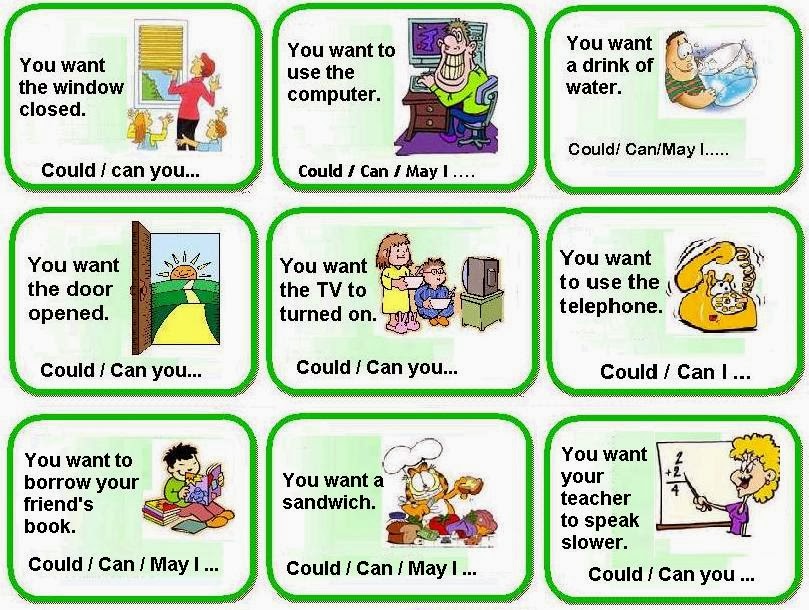
Content:
We use language to request something from other people for example, when we want to borrow something. We use “will”, “could” and “please” to make request.
Examples are:
Will you pass the ruler, please? (very informal, common between classmates)
Reponse: certainly, here you are.
Would you pass the water, please? (more formal)
Would you mind passing the book, please? (most formal)
certainly
Would you mind lending me your pen?
I’m afraid I can’t. I need it at the moment.
Can I borrow your English textbook? (very informal)
Sorry, not at the moment.
Could I borrow your pen? (more formal, polite and respect)
I’m afraid not. I’m using it.
Could you help me with my assignment? (More Formal)
Sure, here you are.
Please, give me your laptop.
With pleasure. Of course.
Please, help me wash my handkerchief. (More Formal)
Certainly not!

EVALUATION: Make appropriate request for the following situation.
1. Student-student
2. Student-senior student
3. Student-teacher
4. Teacher-teacher
Further Studies 1
Further Studies 2
Further Studies 3
LESSON 43
ASPECT: Composition
TOPIC: Formal Letter (Invitation As a Guest Speaker)
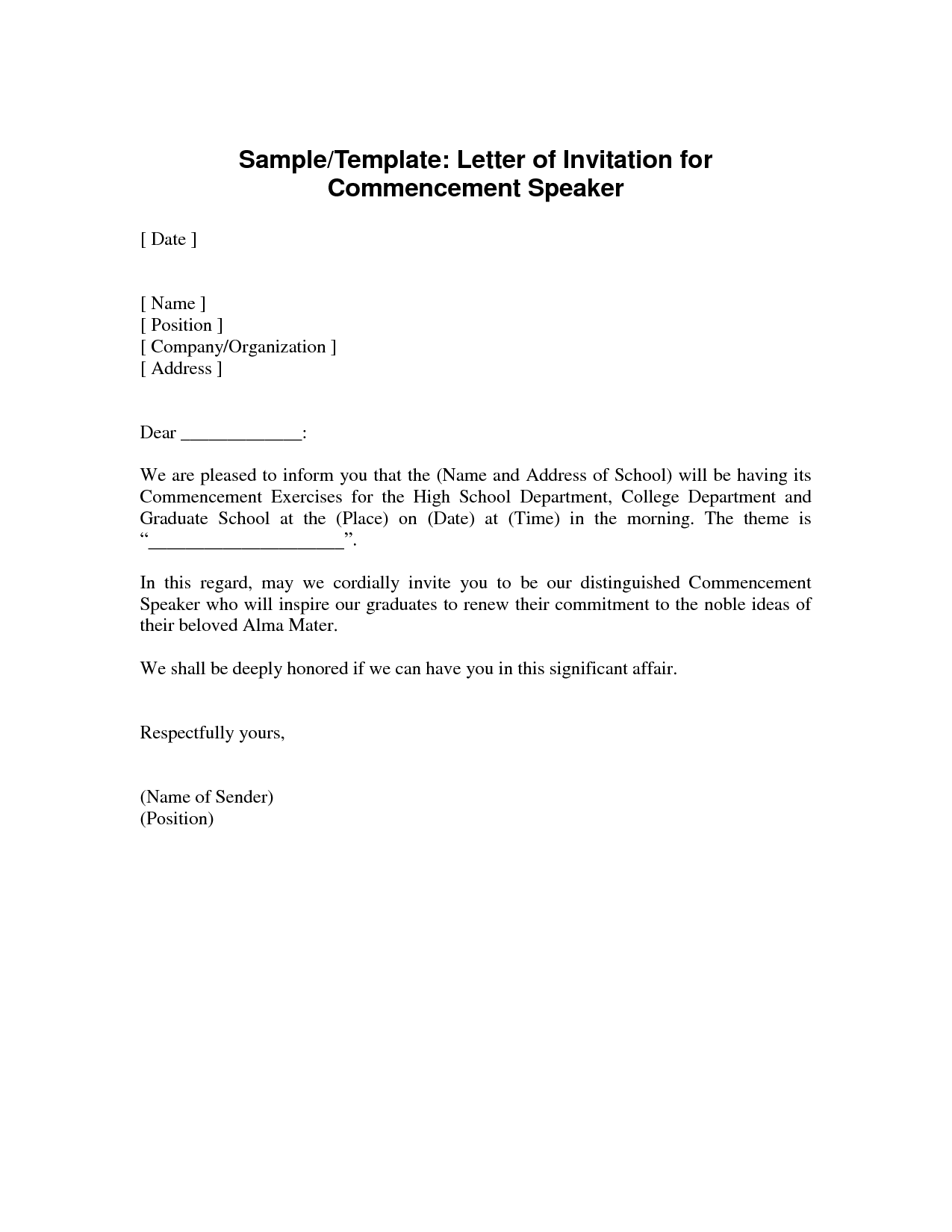
Content:
Formal letter of invitation is a letter of favour or assistance. It can be written to an individual being an invitation as a guest speaker and if such is reasonable, it is often granted. Below are some useful hints on writing a letter of invitation.
a. Make a reasonable request.
b. Identify what you need and give detailed information about it.
c. Send information about the group, association or club.
d. Mention if someone has suggested to you to contact the individual.
e. Ask for alternative help if your request cannot be met.
f. It is better address the letter to the individual to quicken attention.(This should be courteous and friendly without flattery)
Sample invitation letter to a Guest Speaker
My name is Justus Elijah, the Principal of Pen-Write International School. I hereby take this opportunity to invite you to our school to share your knowledge and provide guidance to our SS 3 students, who are looking forward to their WASCE Exams and seeking a bright career ahead.
I appreciate you being the best Student Counselor in Lagos; and will feel honoured by your gracious presence at our school. Not only the students, even our teaching faculty look forward to learning a lot many things to guide our students and shape their career. I understand students are clay in the hands of our sculptures alias teachers. We have the key responsibility to observe their field of excellence and mould them accordingly to give them a cherishing life ahead.
I want you to help our passing out students with the available career options, their importance, the relevance of specific fields in industry and placement opportunity in every field. Our students might be having a plenty of questions to opt for a career path. Many a times, students are constrained to specific fields like medicine or engineering, just due to their mere negligence of the upcoming fields and their importance in job market. This lecture of yours could provide them a wide range of opportunities and a clear picture of the actual place of the field in real world.
I want to know the availability of your time in your busy schedule, so that I can have an appointment with yourself and make appropriate arrangements. Also I would like to have a rough idea for the time-frame of the lecture and discussion session.
Eagerly awaiting your response. Please feel free to contact me anytime on call on 080xxxxxxx.
Thanking you in anticipation.
Yours sincerely,
(Signature)
Justus O. Elijah
EVALUATION: Write a letter of invitation to a guest speaker to speak on a topic of your choice at an event to hold in your school.
Further Studies 1
Further Studies 2
LESSON 44
ASPECT: Literature
TOPIC: Synecdoche, Onomatopoeia, Antithesis
Content:
Synecdoche:
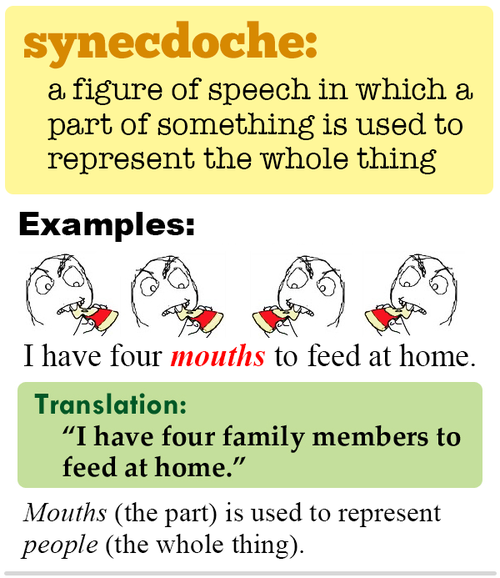
The use of a part of a thing to represent the whole, or the use of the whole to represent a part
e.g.
1. Thousands of heads were counted during the census exercise (the head represents the whole body)
2. All hands should be on deck.
Onomatopoeia:

It involves words that echo or imitate the sounds of the things they represent.
E.g.
“crash”, “cuckoo”, “squeak”, “sizzle”, “click”.
“creaking and shuffling… thus, as five hundred boys of different sizes lowered themselves into the chains”
Antithesis:

it is the choice and arrangement of words to emphasize oppositeness or contrast,
e.g.
1. Man proposes, God disposes.
2. This is an insult on both the dead and the living of the village.
3. I toil day and night.
ASSIGNMENT: Choose the appropriate form of verb in the bracket to fill in the blank space.
E.g. I have never visited (visit) Lagos.
1. They have _____ (drive) a very long way, so they must feel very tired.
2. Listen! The clock ________( strike) seven, eight, nine!
3. Johnson has _______ (grow) a lot in the last year.
4. He often _____ (fall) sick with malaria, and I often buy medicine for him.
5. They (sleep) when the thief entered their room.
Further Studies 1
Further Studies 2
Further Studies 3
Further Studies 4
Further Studies 5
Further Studies 6
Further Studies 7
ASPECT: Speech Work
TOPIC: Monophthongs
CONTENT:
MONOPHTHONGS:

They are vowel sounds whose quality doesn't change over the duration of the vowel .It is a speech sound that consist of only one vowel sound. Monophthongs are sometimes called "pure" or "stable" vowels. E.g.
/e/- set, pet
/u:/ - boot, school
/I/- sit, big
/ə/- away, police
/æ/- bag, bad
/Ӡ:/- bird, burn
/D/ - Pot, hot
/Ʌ/- love, run
/Ʊ/ - book, bush
/ↄ:/ - saw, horse
https://youtu.be/72M770xTvaU
Realizations of the sounds are analyzed in the examples below:
Monothongs -------Realizations
1. /i:/
ee----ea-----e--------i
free--meat—-peter--margarine
bee---sea---we-----machine
tree--beat—-he-----police
need--leaf—-these--kerosine
ie-----ei-----ey-----uay
chief—-seize—-key----Quay
field--receive
thief--deceive
piece--ceiling
https://youtu.be/EuZa9-QbhG8
2. /I/
i------y-------e--------ie-------a
sit----nymph—--pretty---ladies---village
fifth—-rhythm—-wicked—--cities--private
rich---symbol—-careless-parties--manage
trick—-lynx----houses---carries--savage
https://youtu.be/7PpuPMrISVc
3. /e/
e-----ea-----a-----ie-----u-----ai
met---dead---any---friend-bury--said
red---read---many
bed---breath-Thames
help--instead
https://youtu.be/d98t4b3XLjg
4. /æ/
a-----ai
ram---plait
lamb
gnat
https://youtu.be/NavmTDkd8Z8
5./a:/
a------ar------ear-----er-------al-----au
pass---arm-----heart---clerk----half---aunt
father-star----hearth—-sergeant-calm---laugh
after—-part---------------------palm
https://youtu.be/1F47WdIjn5U
5. /Ɔ /
– o----a----au
sorry was because
pot what sausage
rock quality Austria
long quantity
porridge want
https://youtu.be/A3l-yWQfIW4
7./ Ɔ: /
or----aw---ou-----au------a
cord law bought daughter all
horse saw thought cause water
for lawn ought caught call
ar----ore---oor—our---oar
war before door four board
quarter store floor court
https://youtu.be/Bc1tCtP2ZSg
8./u/
u----ou----o----oo
put could wolf good
full should woman book
sugar would wool food
https://youtu.be/5lOF-zRg8x0
9./u:/
o---oo----u---ou
do food rude group
who soon tune soup
move moon June through
ew---ue----ui----oe
chew blue juice shoe
stew sue suit
drew true fruit
https://youtu.be/qPB0Ajjs7nE
10. /Λ /
u-----ou-----o---oo
cup country ton blood
nut young---son flood
lust couple come
luck cousin does
sun---------love
https://youtu.be/zUpF0pYoTZ8
11./3:/ -er ear or ir ur our
herb earth worm bird turn journey
serve heard word shirt church courtesy
germ early world girl hurt scourge
https://youtu.be/dweBtpz3gco
12. /ә/
a-------u-------er------or
about support perhaps tailor
away
hyena
ou--------o------ure
famous purpose treasure
ar-------e
pillar Helen
https://youtu.be/RVvn6204I_Y
This is called the SHWA sound, the weak form of all the vowels sounds i.e. any monothong or diphthong caught in a weak
environment changes to SHWA.
e.g. Her =/ha:/ in weak form /hә/
of =/Λf/ in weak form /әv/
A =/ei/ in weak form /ә/
Pronunciation Practice
https://youtu.be/2VJBfJPxxMw
https://youtu.be/RZmGzSb-6OM
https://youtu.be/TBp_5yKC2OA
https://youtu.be/T-BUlk9im58
https://youtu.be/35rzq87Ck3M
https://youtu.be/C_Lfq_CFAQ8
https://youtu.be/TNFKG0yvDx4
https://youtu.be/eJ7dM_LU9t4
https://youtu.be/PZwKFFp7V50
https://youtu.be/MAk-XtHsyzM
https://youtu.be/hLN1cdSTDo8
https://youtu.be/qVhaIHk88a8
https://youtu.be/wg0P0oYkniE
EVALUATION
1. What is monophthong?
2. Give five examples of monophthong with two examples each.
LESSON 42
ASPECT: Grammar
TOPIC: Making Request Using - Will, Could, Please

Content:
We use language to request something from other people for example, when we want to borrow something. We use “will”, “could” and “please” to make request.
Examples are:
Will you pass the ruler, please? (very informal, common between classmates)
Reponse: certainly, here you are.
Would you pass the water, please? (more formal)
Would you mind passing the book, please? (most formal)
certainly
Would you mind lending me your pen?
I’m afraid I can’t. I need it at the moment.
Can I borrow your English textbook? (very informal)
Sorry, not at the moment.
Could I borrow your pen? (more formal, polite and respect)
I’m afraid not. I’m using it.
Could you help me with my assignment? (More Formal)
Sure, here you are.
Please, give me your laptop.
With pleasure. Of course.
Please, help me wash my handkerchief. (More Formal)
Certainly not!

EVALUATION: Make appropriate request for the following situation.
1. Student-student
2. Student-senior student
3. Student-teacher
4. Teacher-teacher
Further Studies 1
Further Studies 2
Further Studies 3
LESSON 43
ASPECT: Composition
TOPIC: Formal Letter (Invitation As a Guest Speaker)

Content:
Formal letter of invitation is a letter of favour or assistance. It can be written to an individual being an invitation as a guest speaker and if such is reasonable, it is often granted. Below are some useful hints on writing a letter of invitation.
a. Make a reasonable request.
b. Identify what you need and give detailed information about it.
c. Send information about the group, association or club.
d. Mention if someone has suggested to you to contact the individual.
e. Ask for alternative help if your request cannot be met.
f. It is better address the letter to the individual to quicken attention.(This should be courteous and friendly without flattery)
Sample invitation letter to a Guest Speaker
My name is Justus Elijah, the Principal of Pen-Write International School. I hereby take this opportunity to invite you to our school to share your knowledge and provide guidance to our SS 3 students, who are looking forward to their WASCE Exams and seeking a bright career ahead.
I appreciate you being the best Student Counselor in Lagos; and will feel honoured by your gracious presence at our school. Not only the students, even our teaching faculty look forward to learning a lot many things to guide our students and shape their career. I understand students are clay in the hands of our sculptures alias teachers. We have the key responsibility to observe their field of excellence and mould them accordingly to give them a cherishing life ahead.
I want you to help our passing out students with the available career options, their importance, the relevance of specific fields in industry and placement opportunity in every field. Our students might be having a plenty of questions to opt for a career path. Many a times, students are constrained to specific fields like medicine or engineering, just due to their mere negligence of the upcoming fields and their importance in job market. This lecture of yours could provide them a wide range of opportunities and a clear picture of the actual place of the field in real world.
I want to know the availability of your time in your busy schedule, so that I can have an appointment with yourself and make appropriate arrangements. Also I would like to have a rough idea for the time-frame of the lecture and discussion session.
Eagerly awaiting your response. Please feel free to contact me anytime on call on 080xxxxxxx.
Thanking you in anticipation.
Yours sincerely,
(Signature)
Justus O. Elijah
EVALUATION: Write a letter of invitation to a guest speaker to speak on a topic of your choice at an event to hold in your school.
Further Studies 1
Further Studies 2
LESSON 44
ASPECT: Literature
TOPIC: Synecdoche, Onomatopoeia, Antithesis
Content:
Synecdoche:

The use of a part of a thing to represent the whole, or the use of the whole to represent a part
e.g.
1. Thousands of heads were counted during the census exercise (the head represents the whole body)
2. All hands should be on deck.
Onomatopoeia:

It involves words that echo or imitate the sounds of the things they represent.
E.g.
“crash”, “cuckoo”, “squeak”, “sizzle”, “click”.
“creaking and shuffling… thus, as five hundred boys of different sizes lowered themselves into the chains”
Antithesis:

it is the choice and arrangement of words to emphasize oppositeness or contrast,
e.g.
1. Man proposes, God disposes.
2. This is an insult on both the dead and the living of the village.
3. I toil day and night.
ASSIGNMENT: Choose the appropriate form of verb in the bracket to fill in the blank space.
E.g. I have never visited (visit) Lagos.
1. They have _____ (drive) a very long way, so they must feel very tired.
2. Listen! The clock ________( strike) seven, eight, nine!
3. Johnson has _______ (grow) a lot in the last year.
4. He often _____ (fall) sick with malaria, and I often buy medicine for him.
5. They (sleep) when the thief entered their room.
Further Studies 1
Further Studies 2
Further Studies 3
Further Studies 4
Further Studies 5
Further Studies 6
Further Studies 7